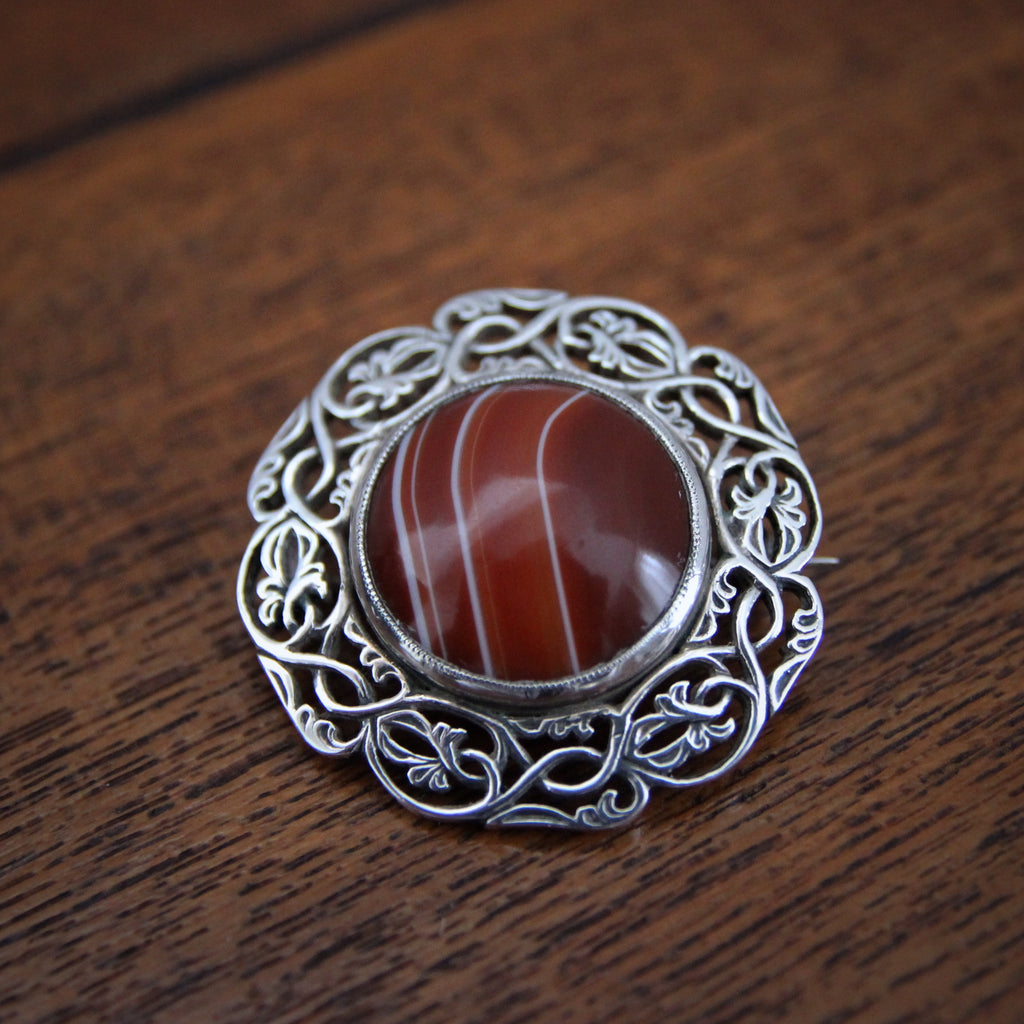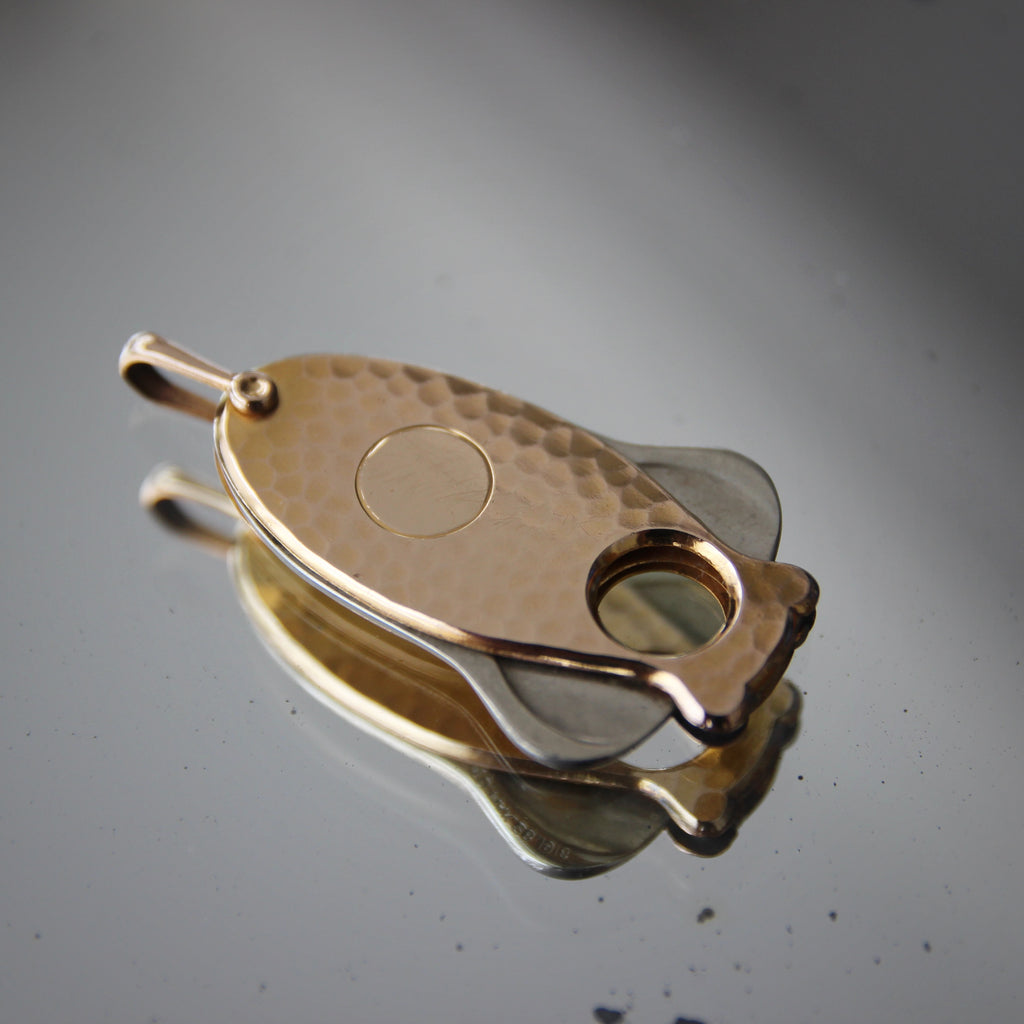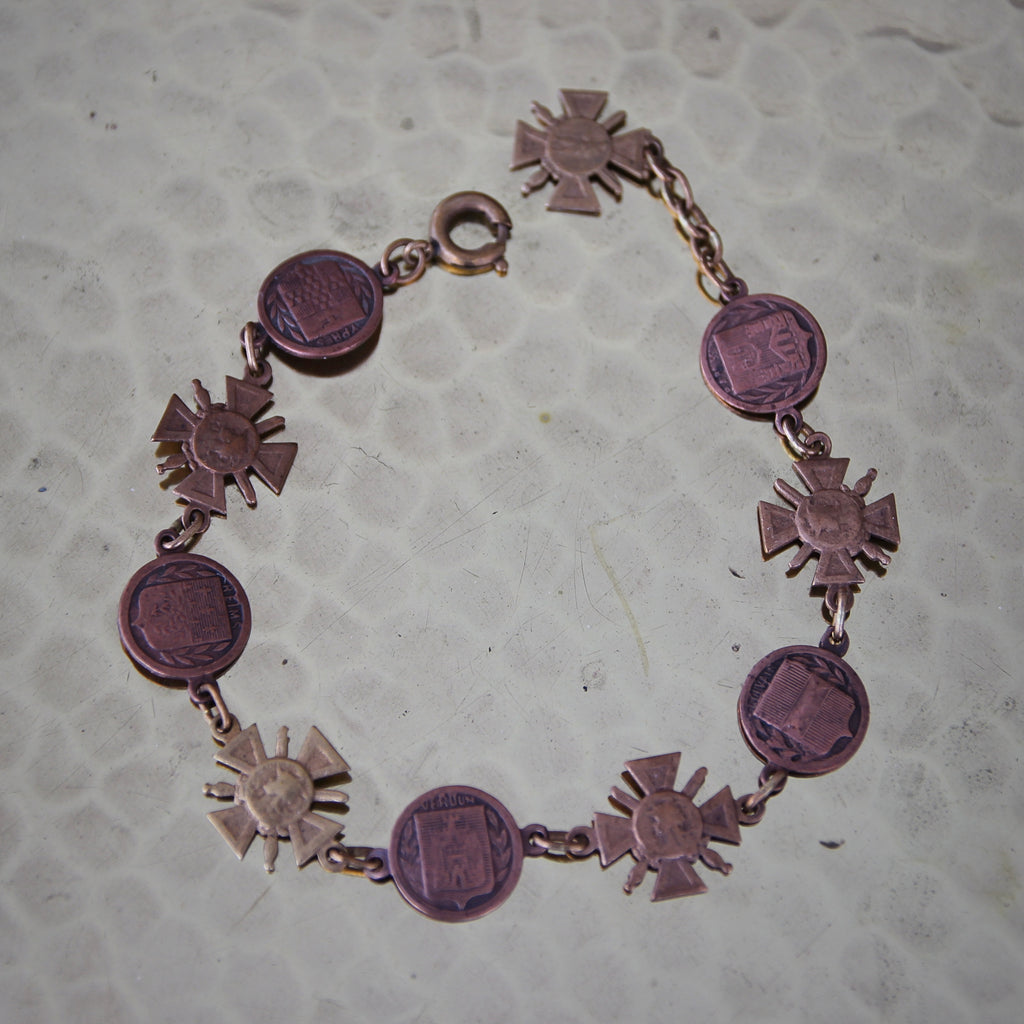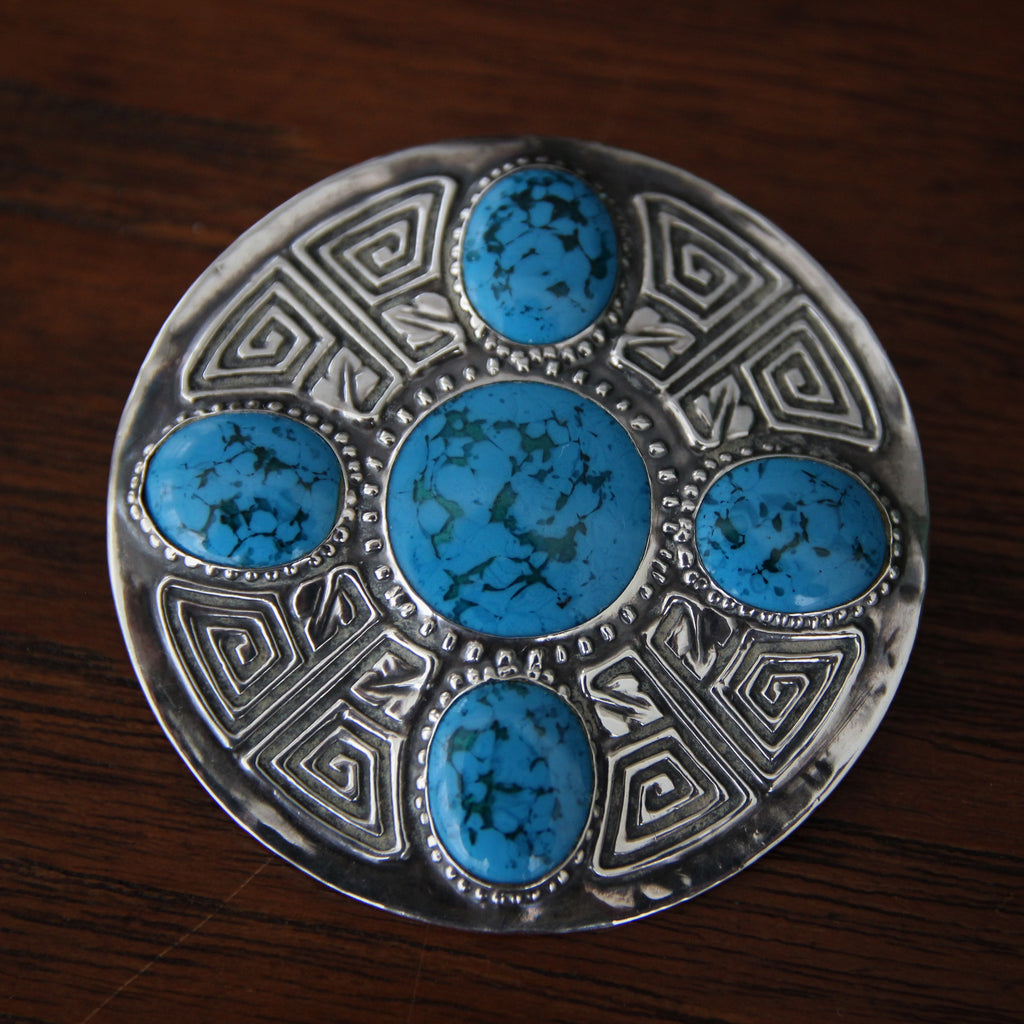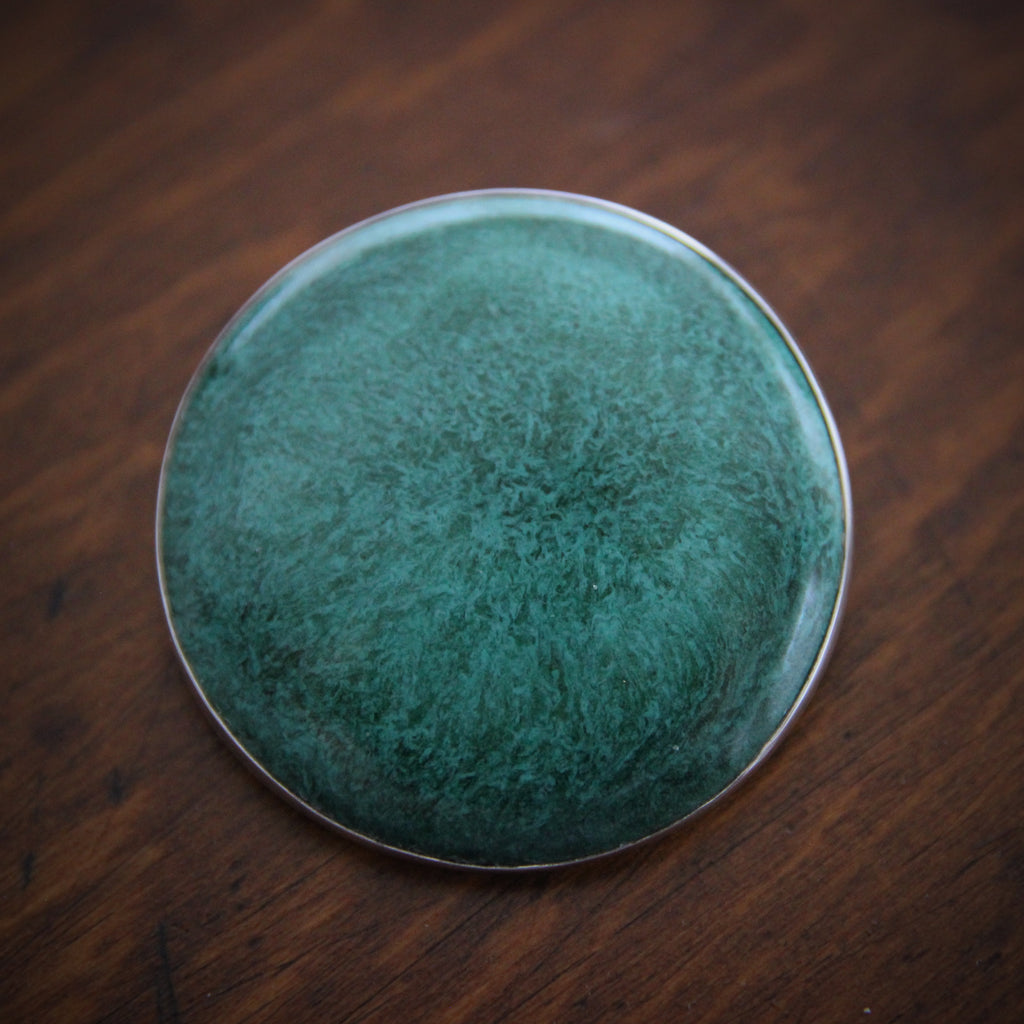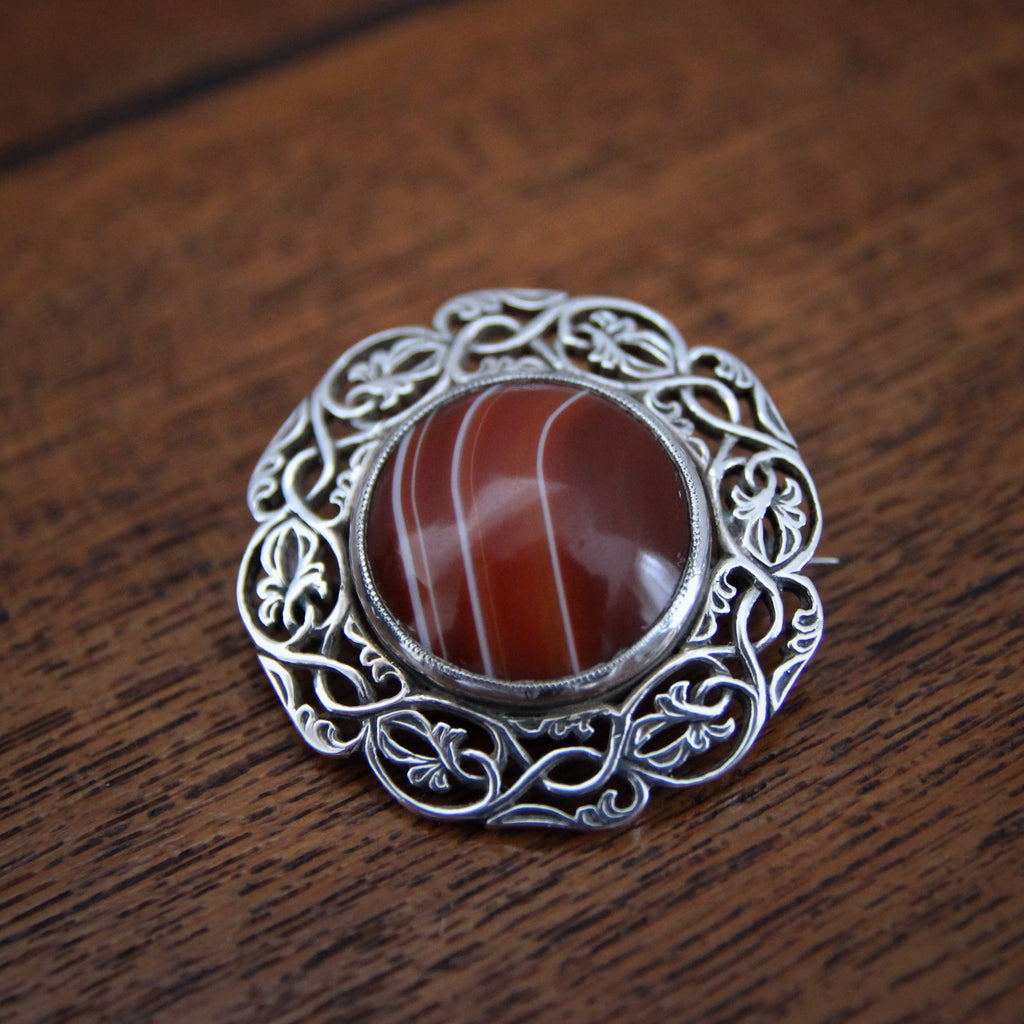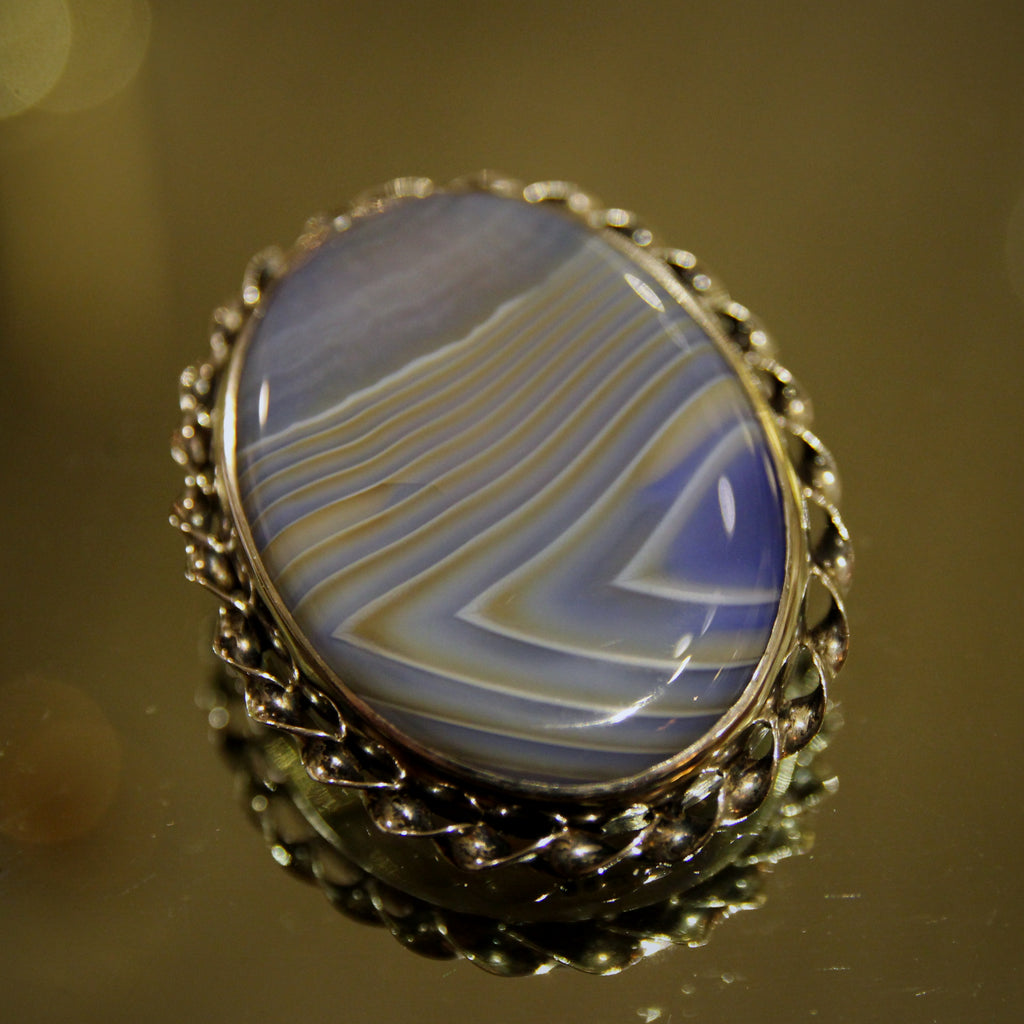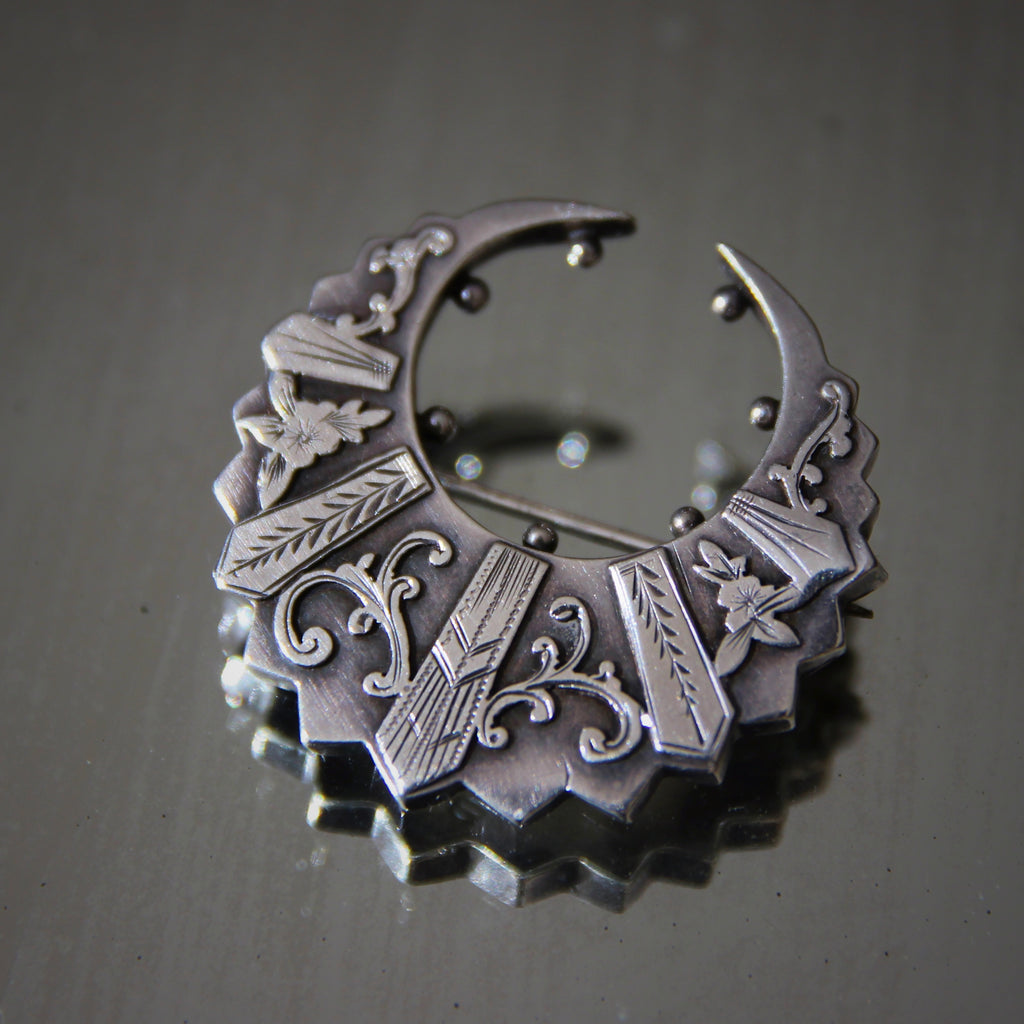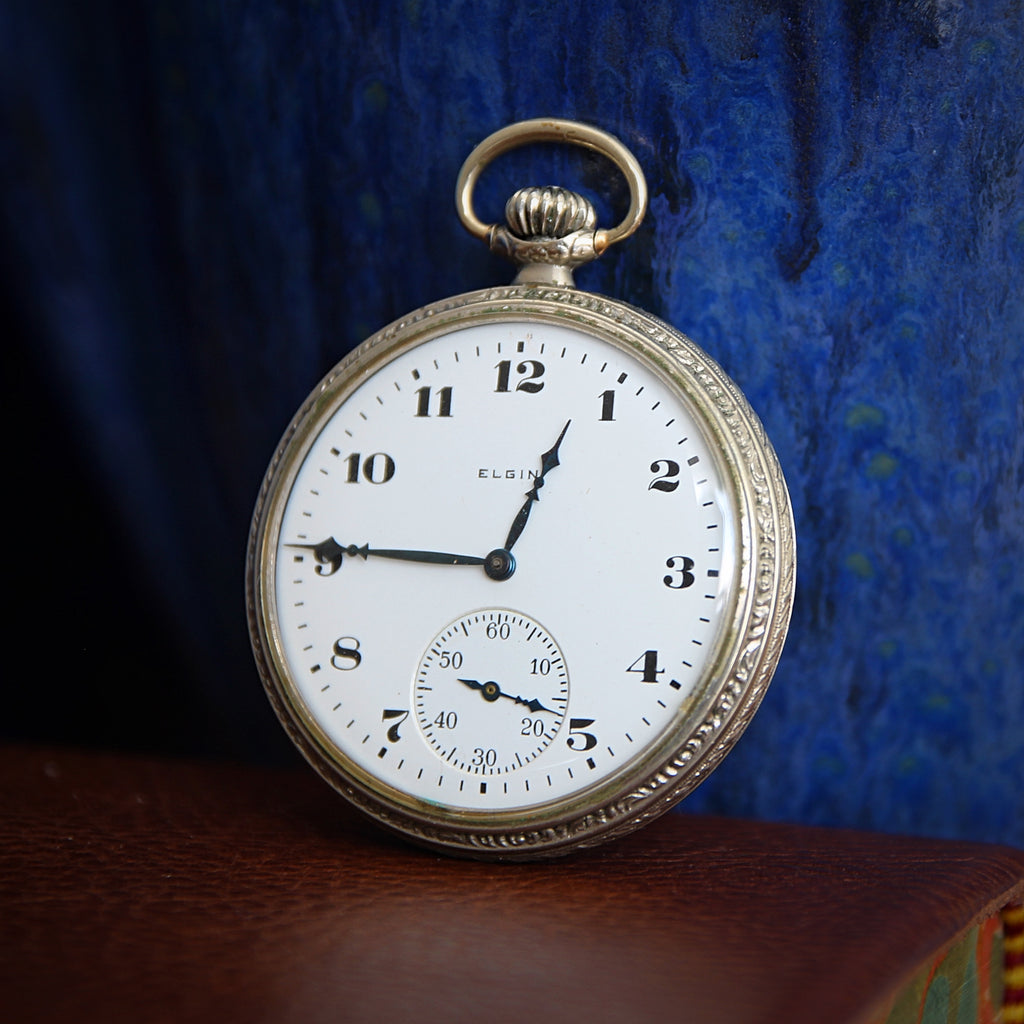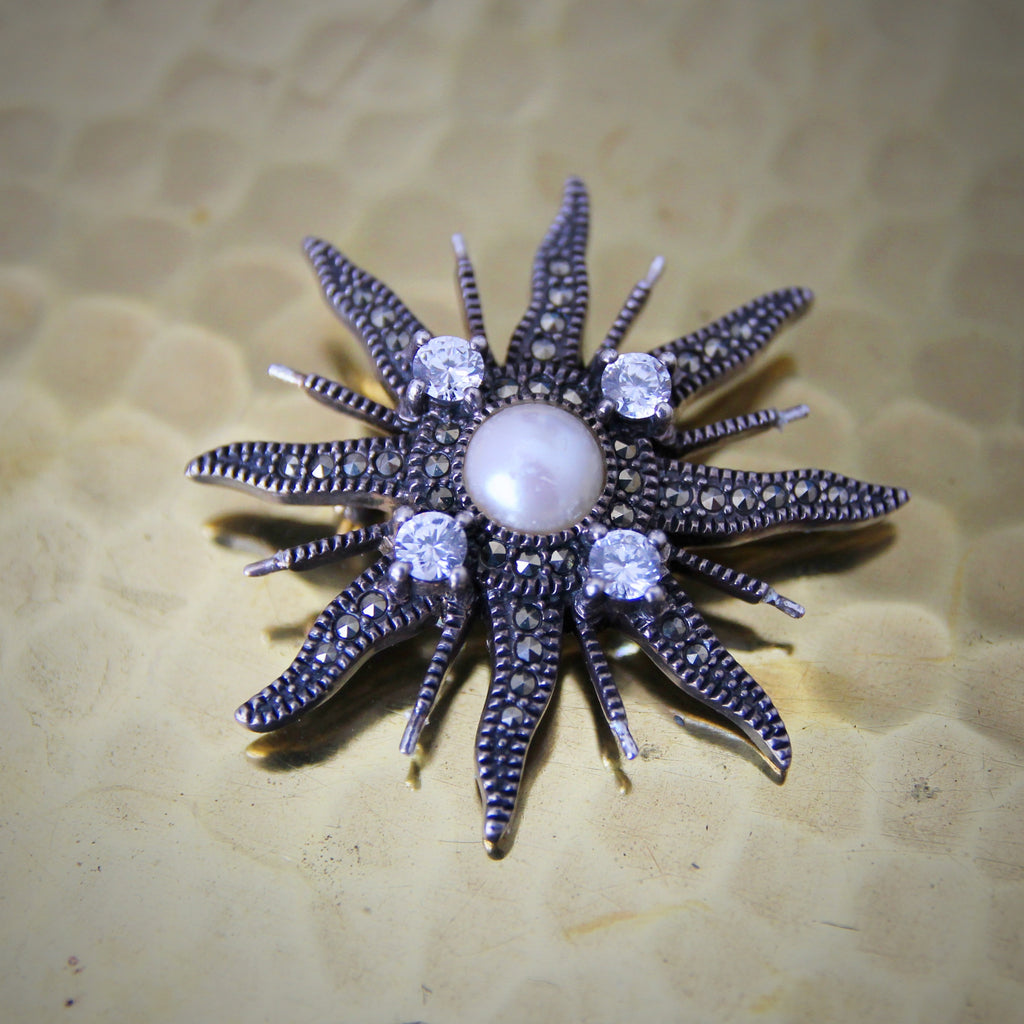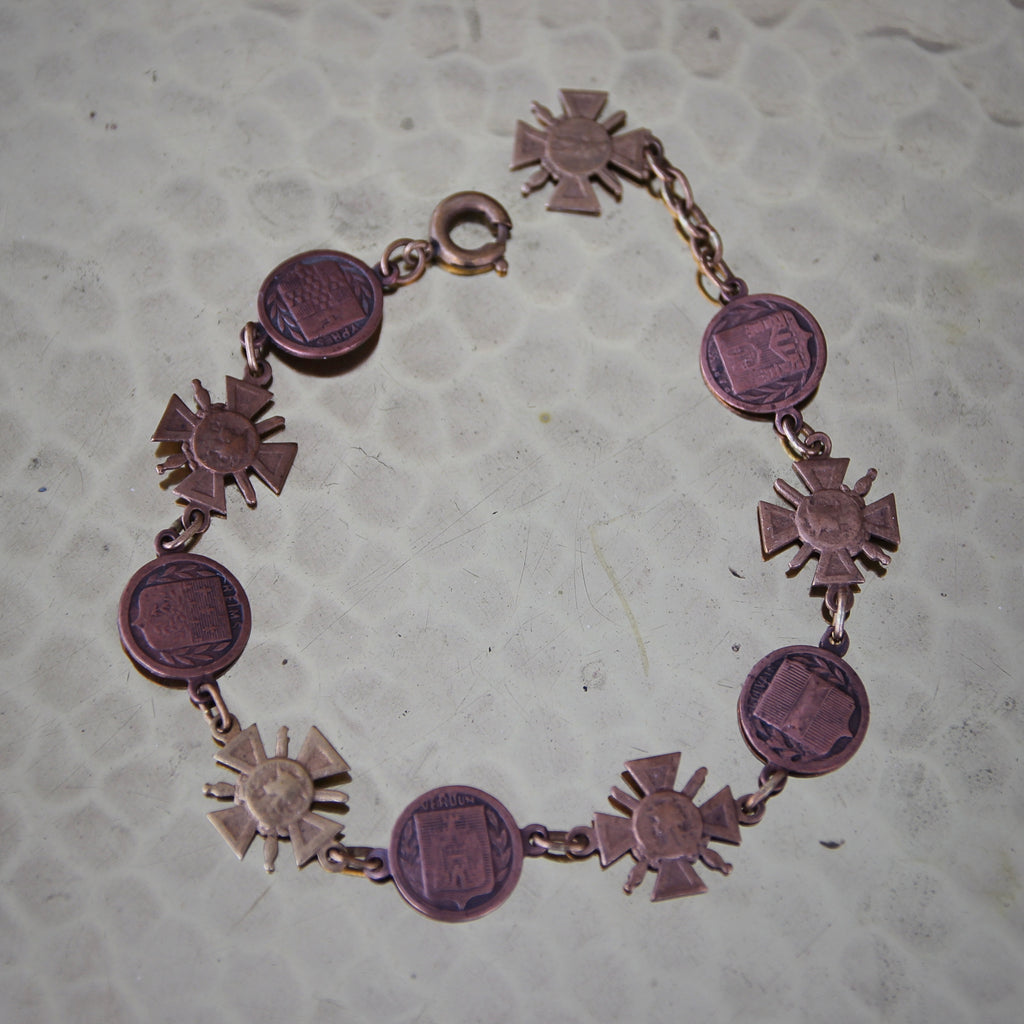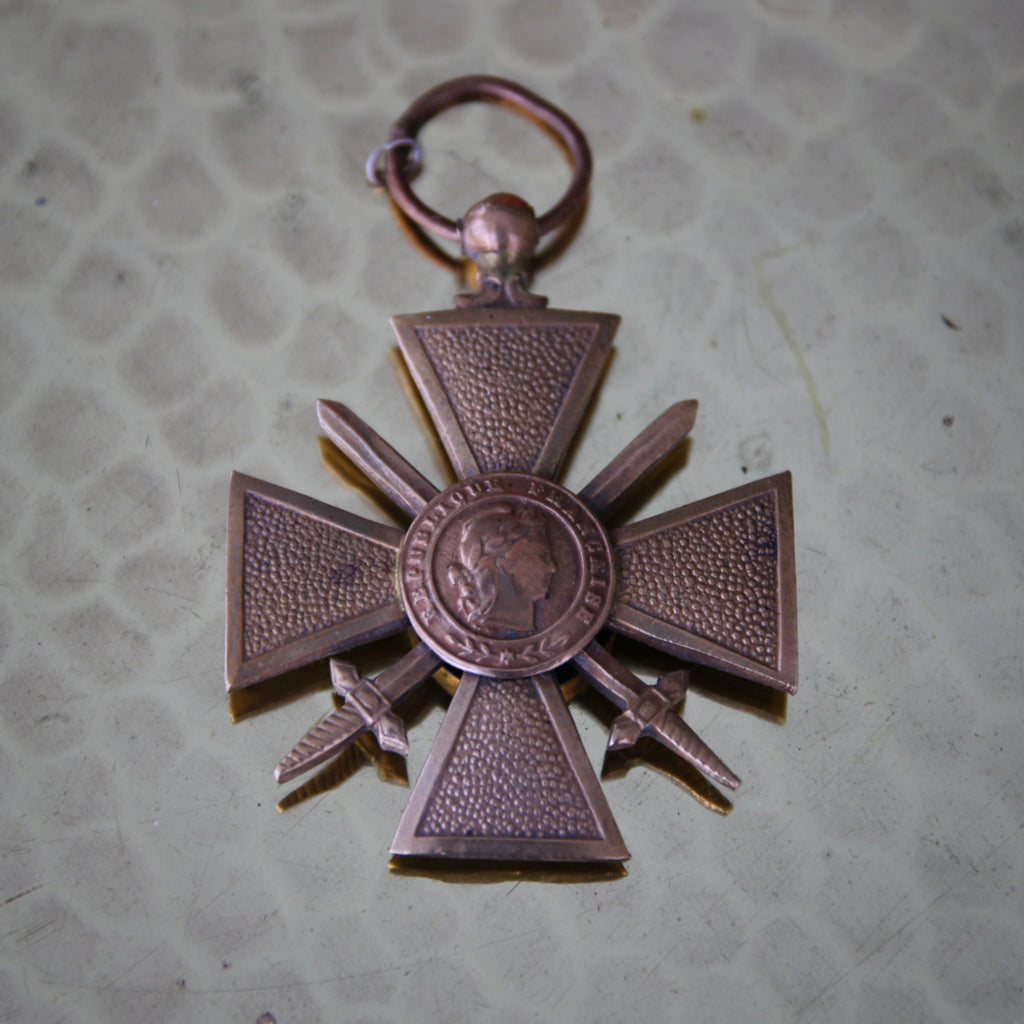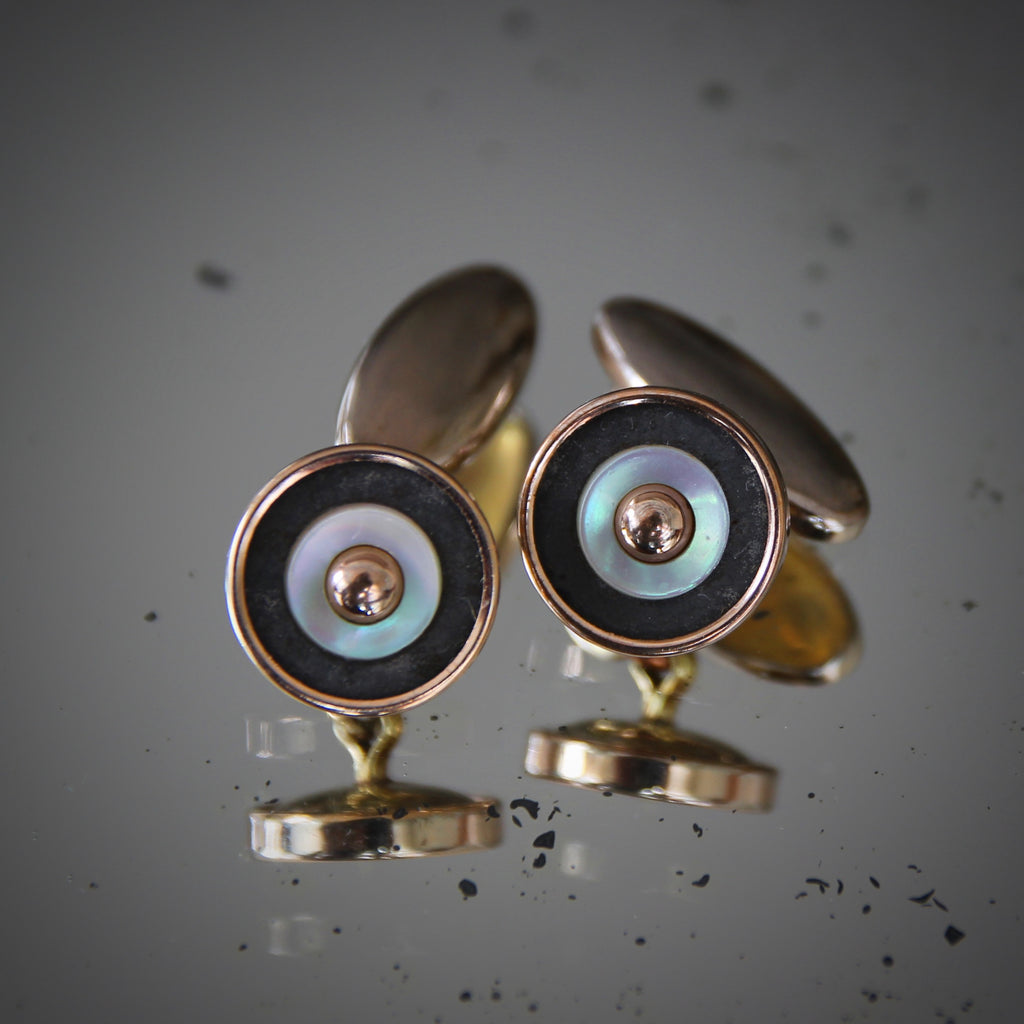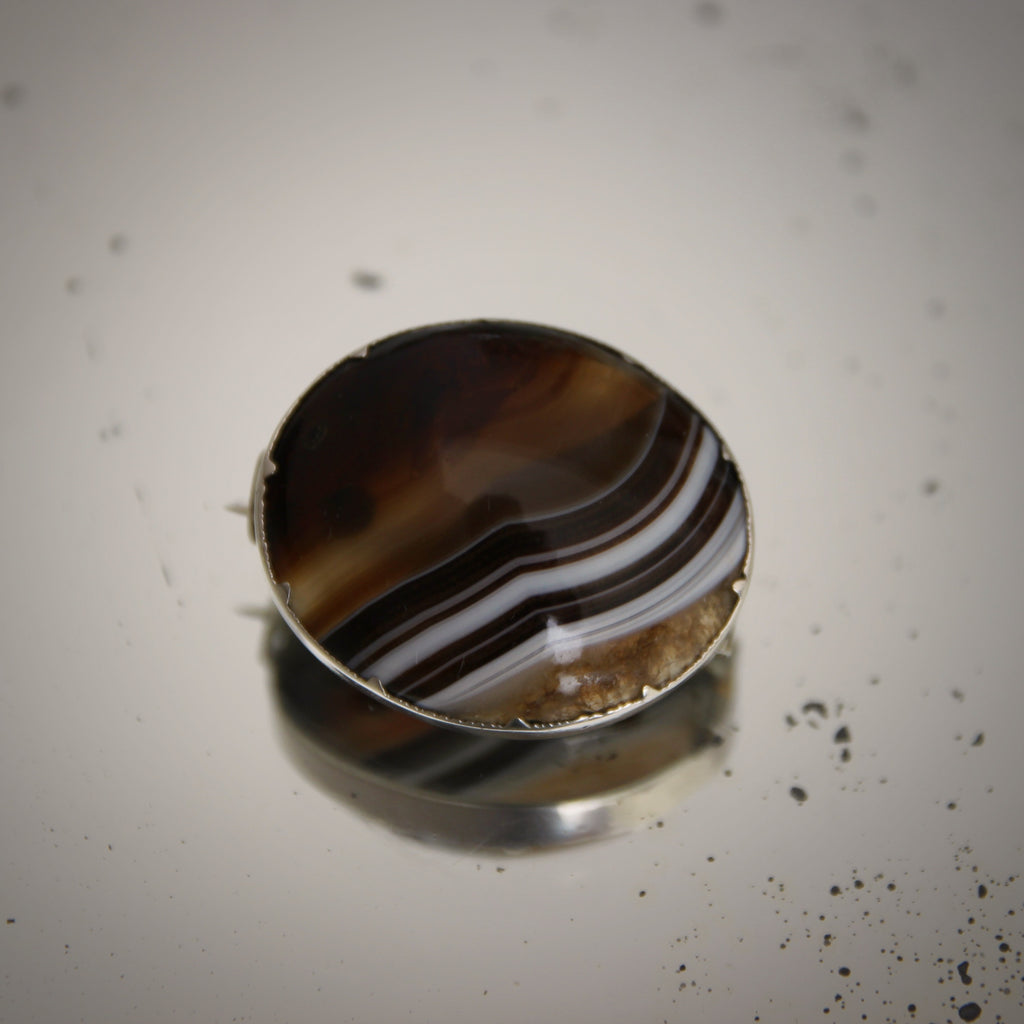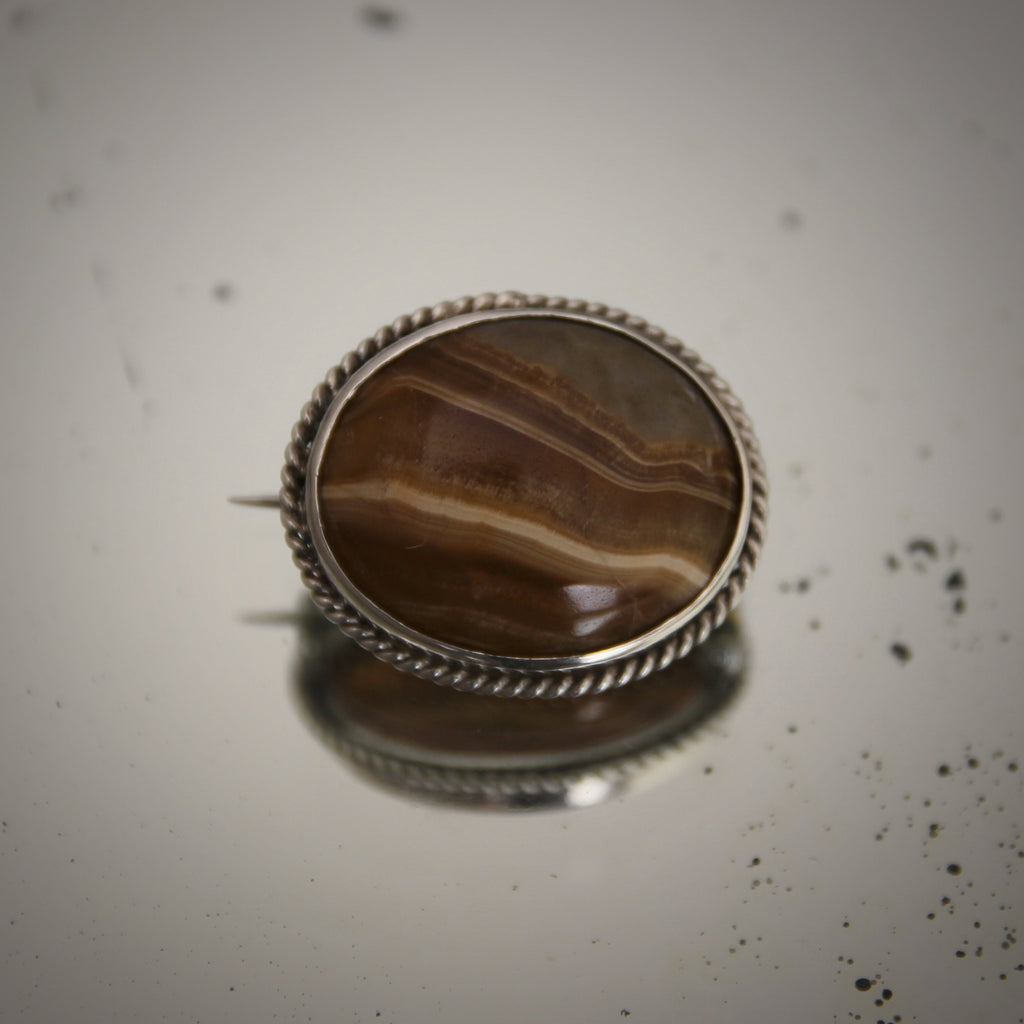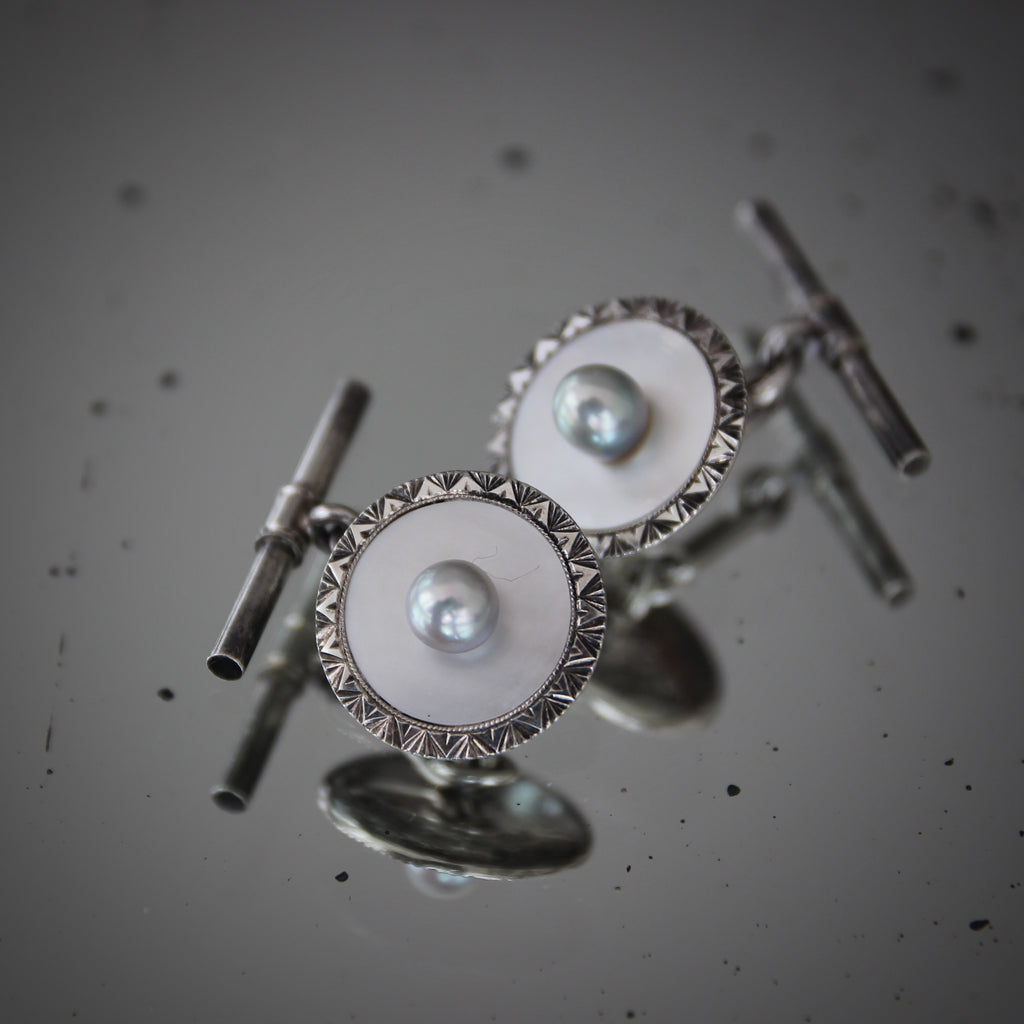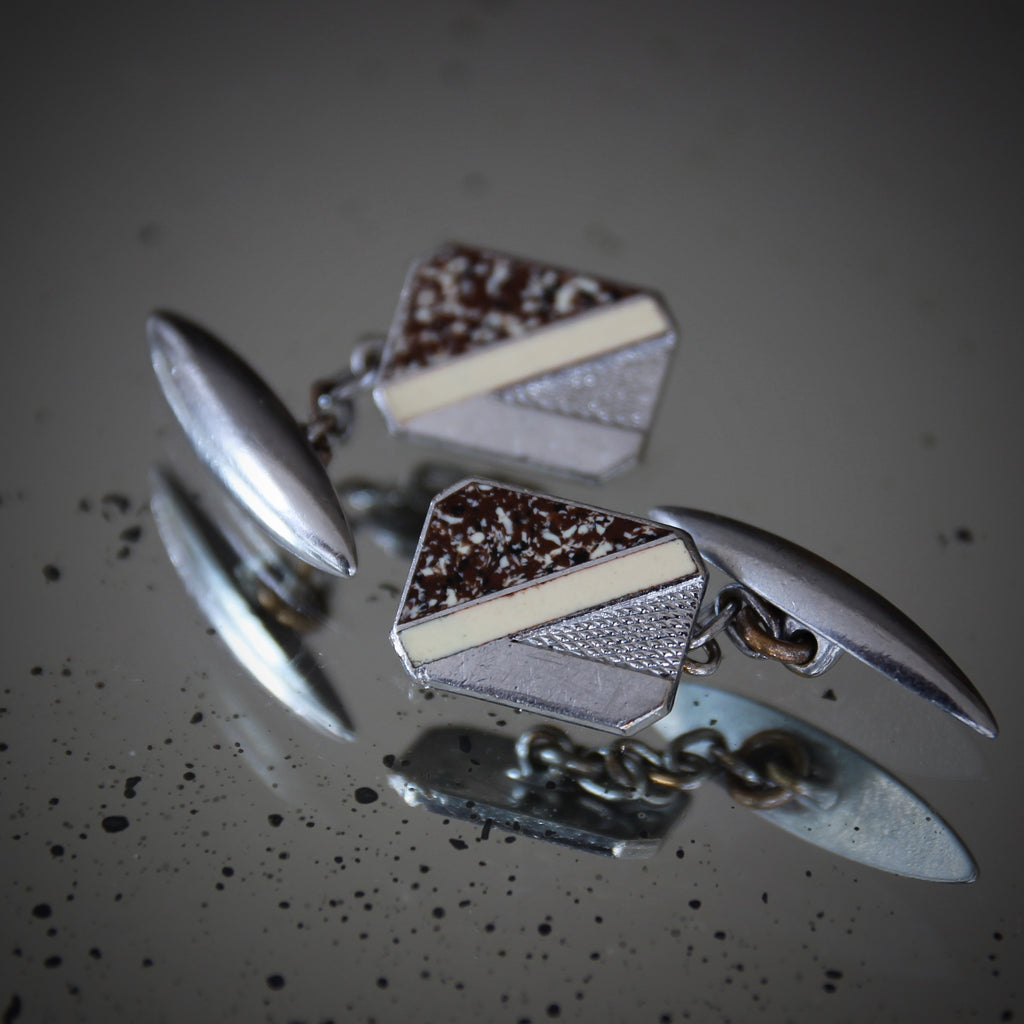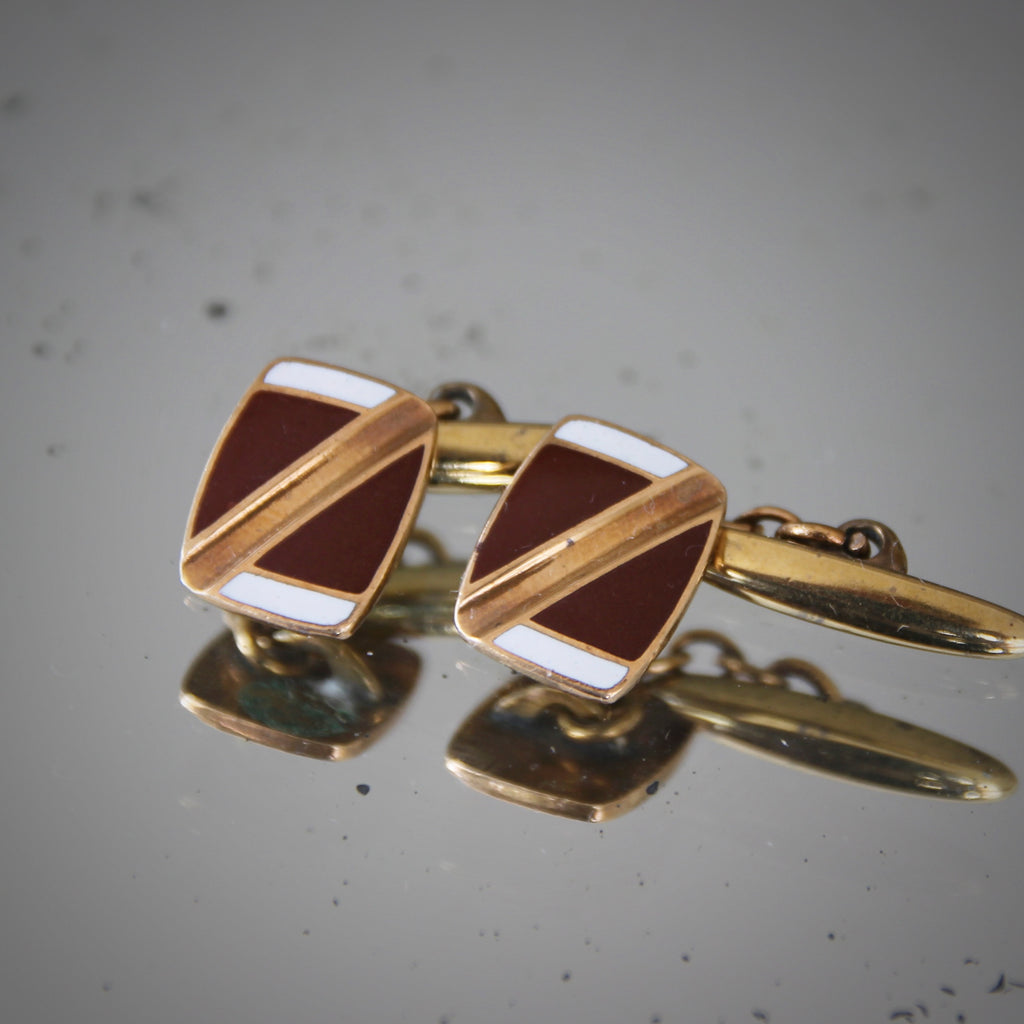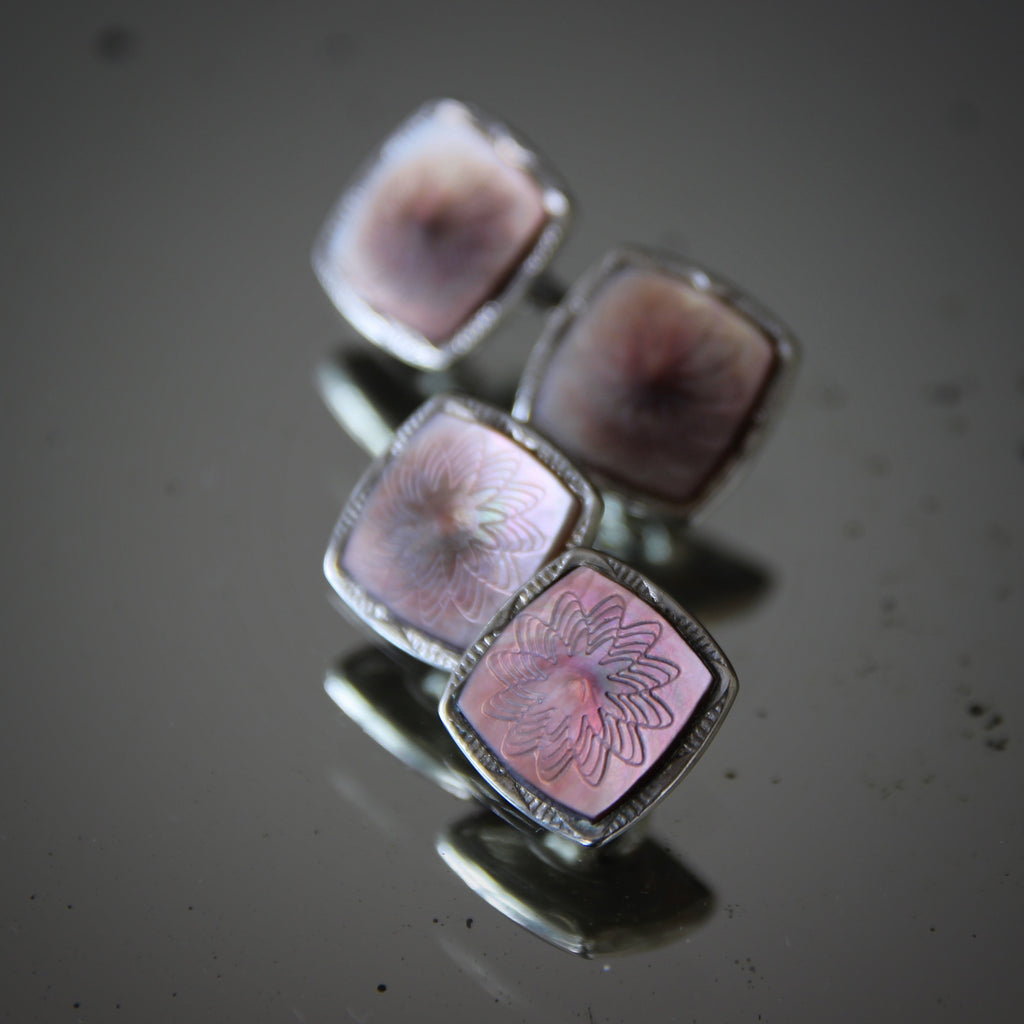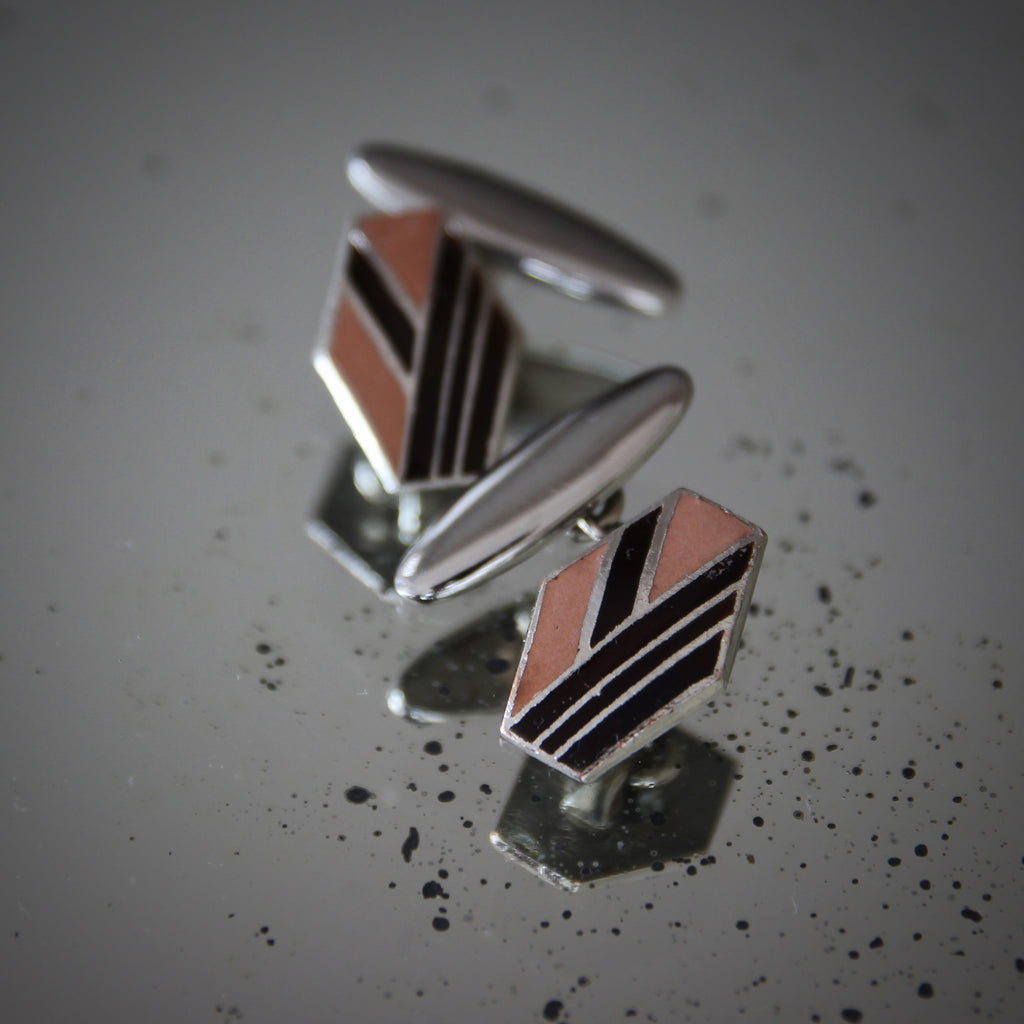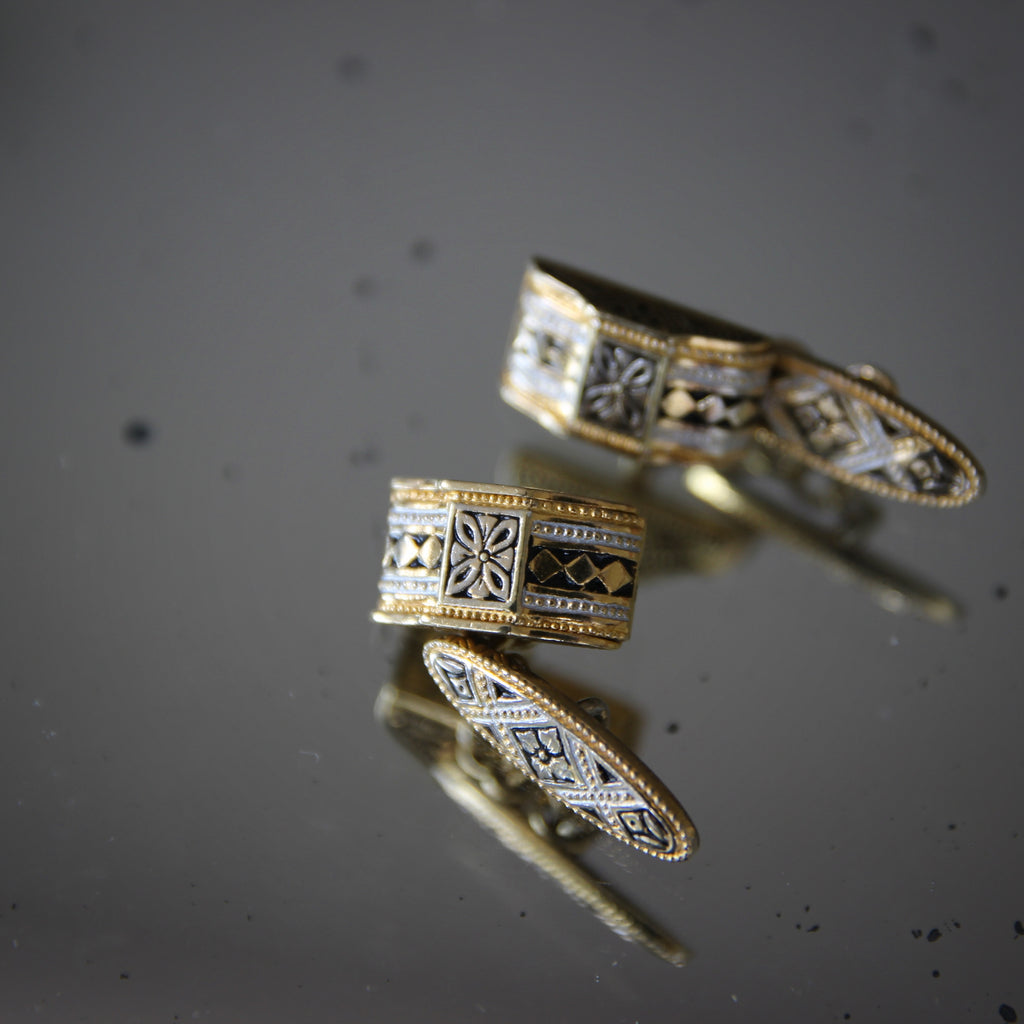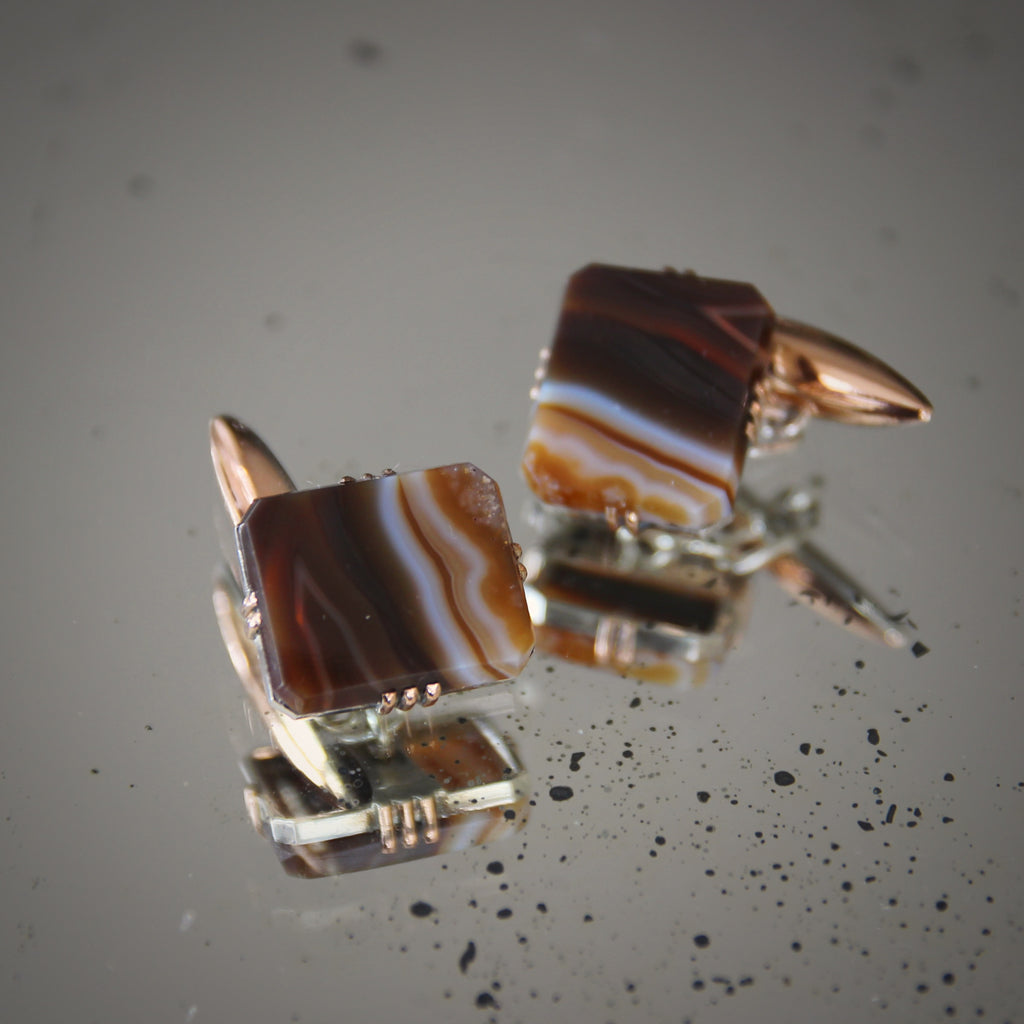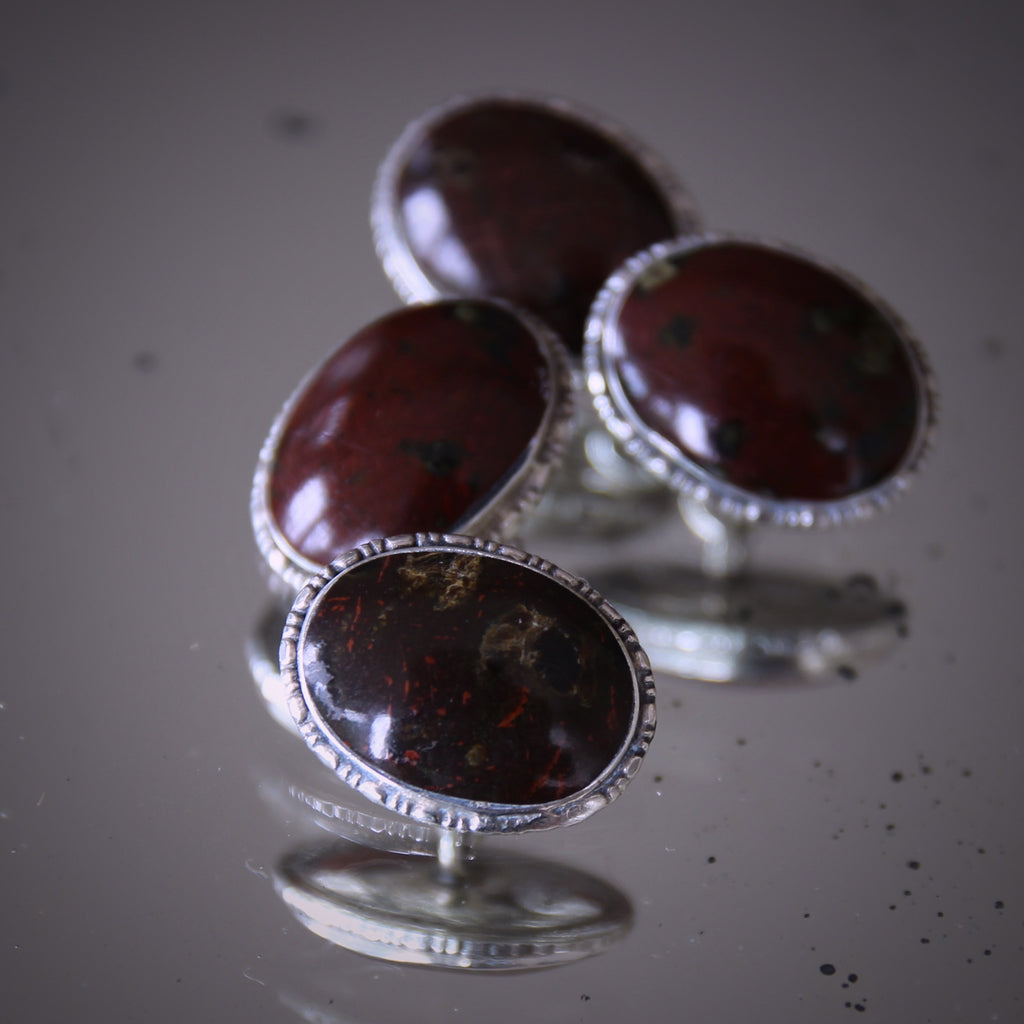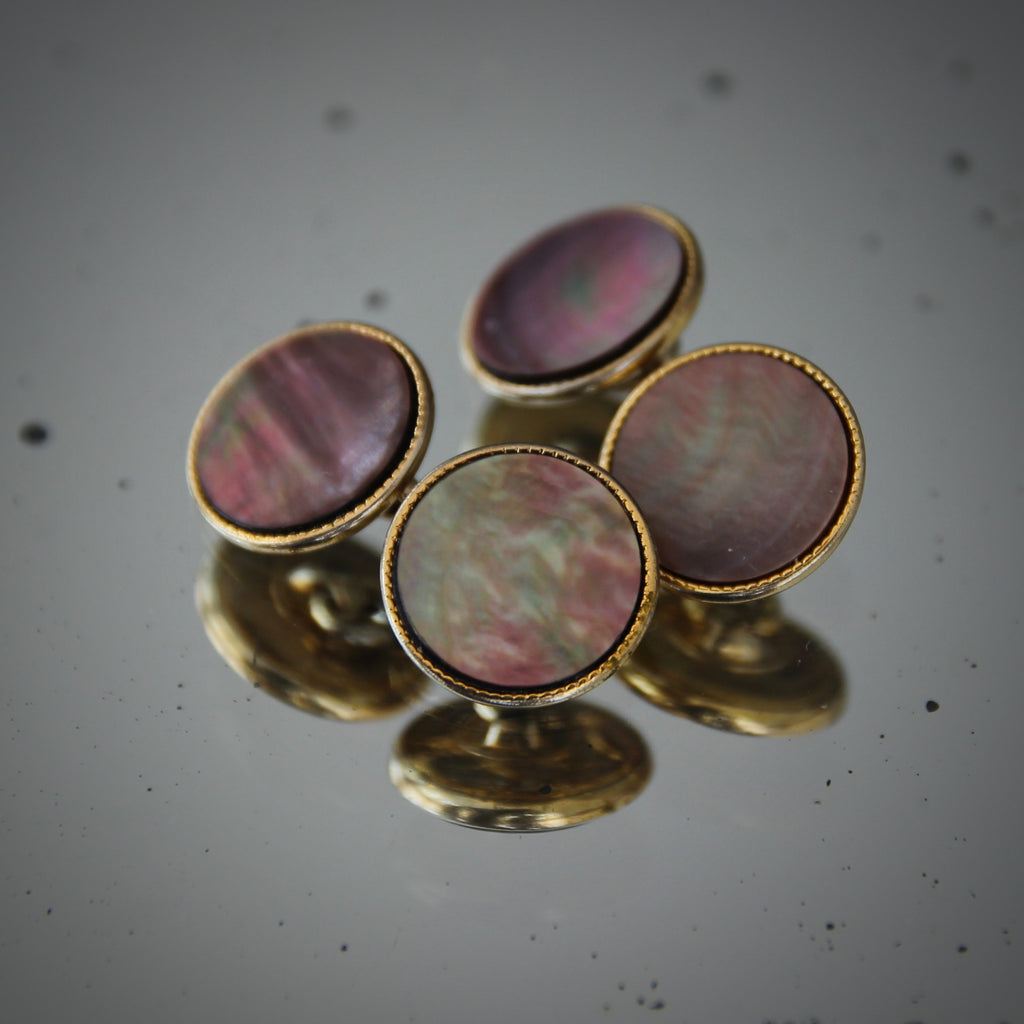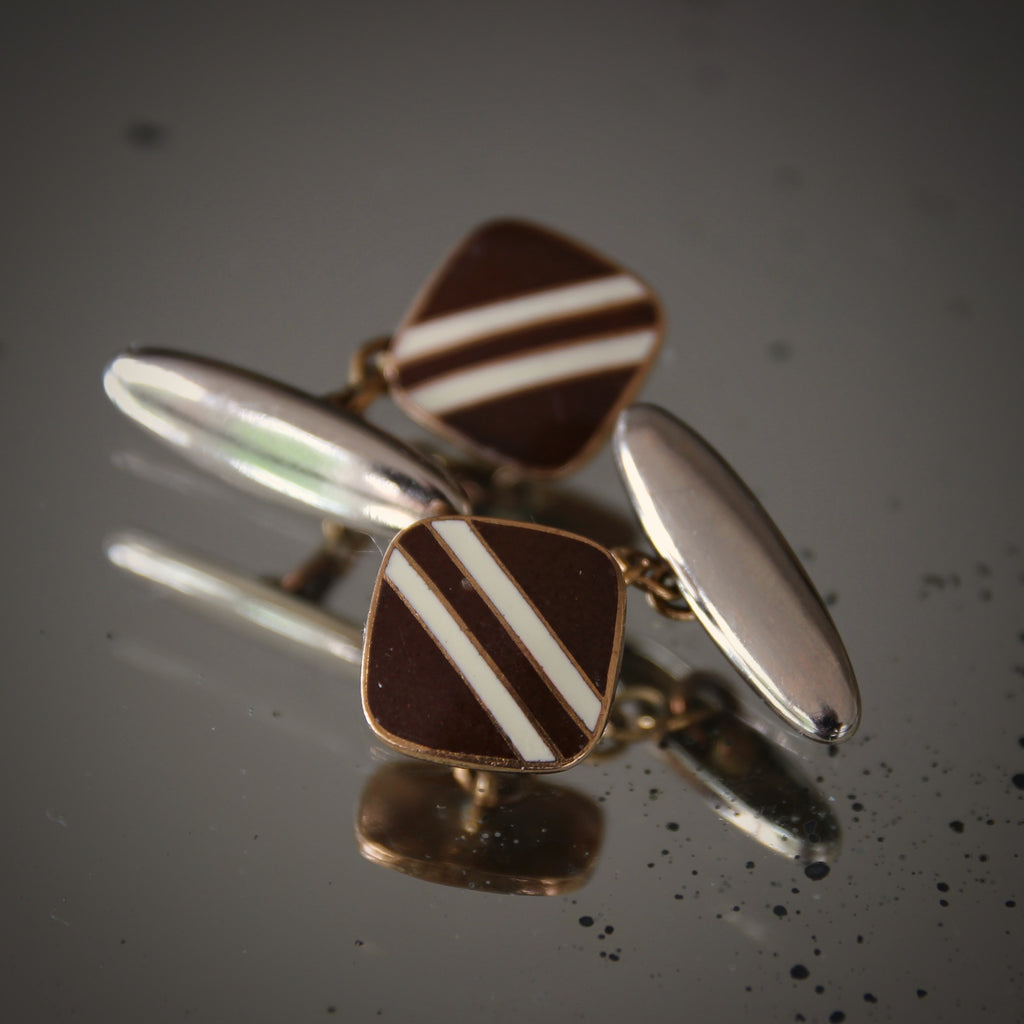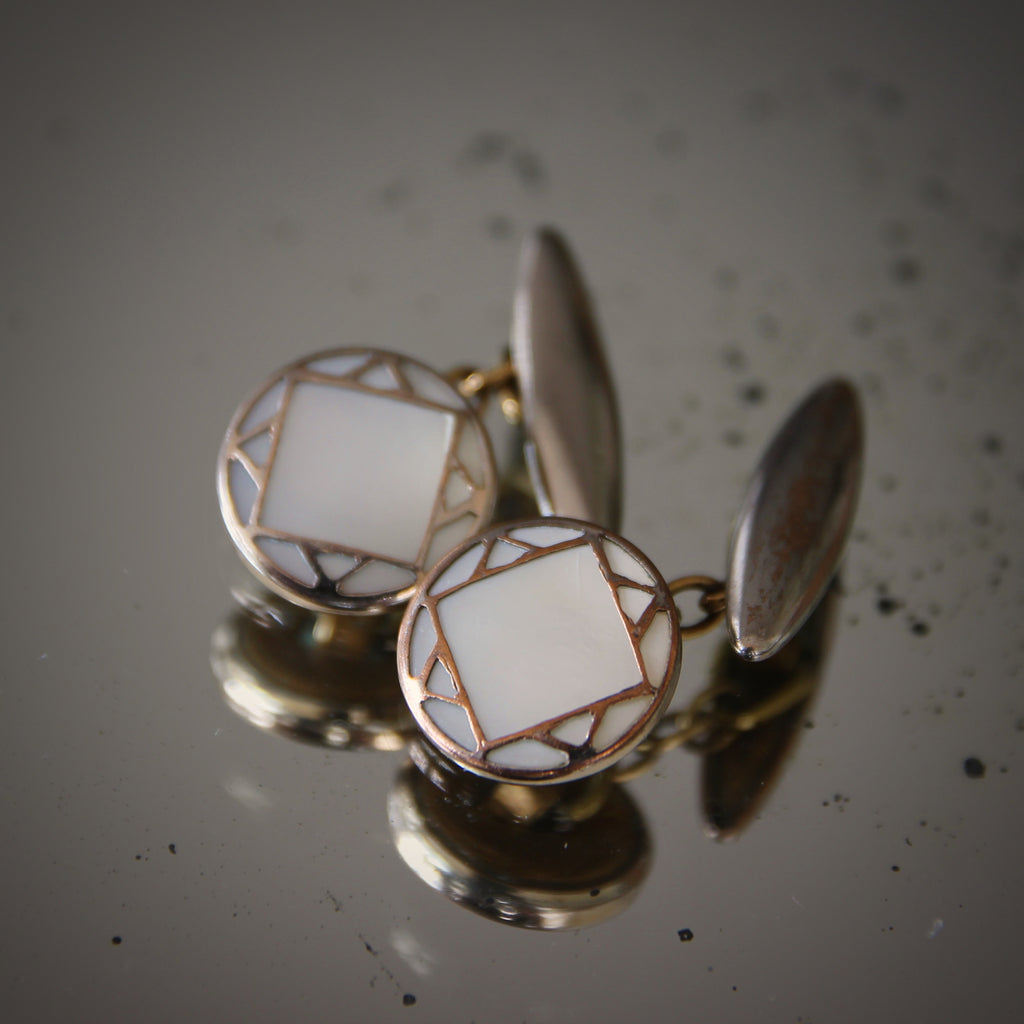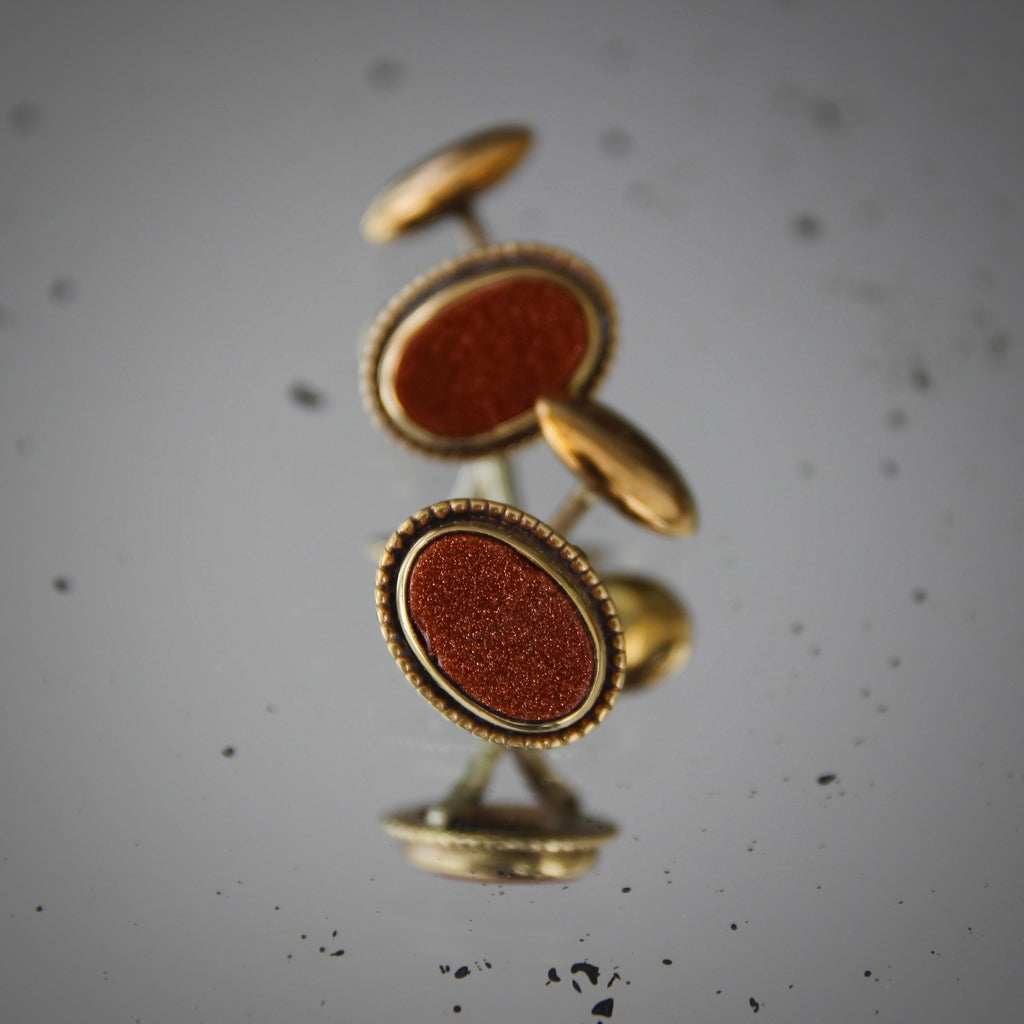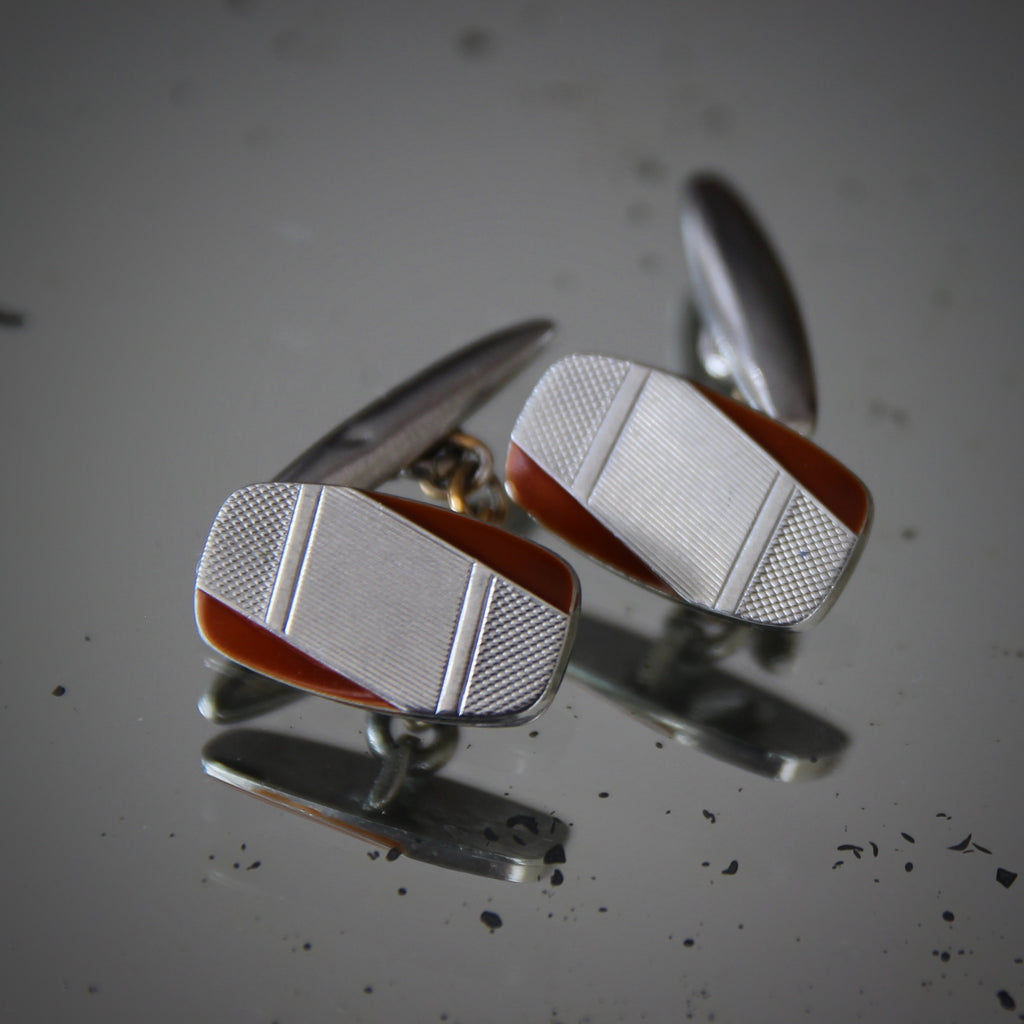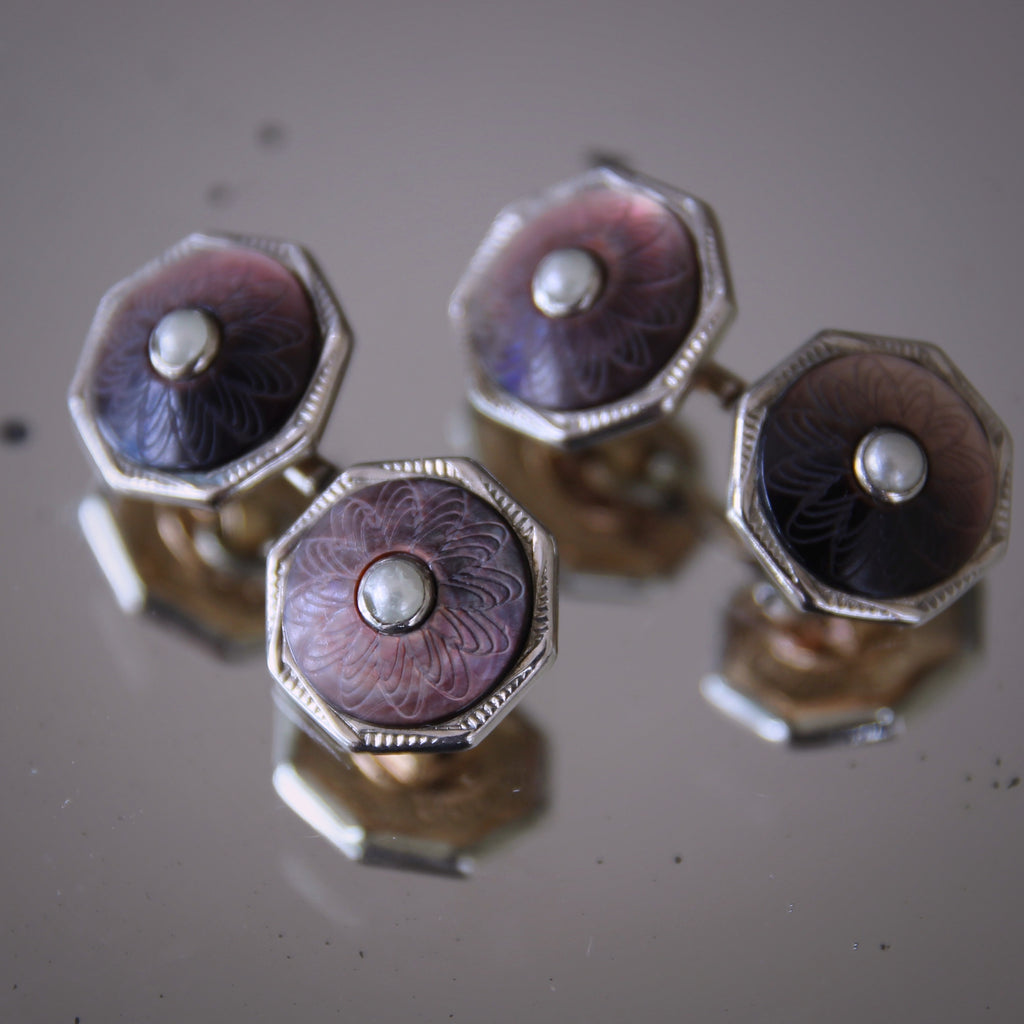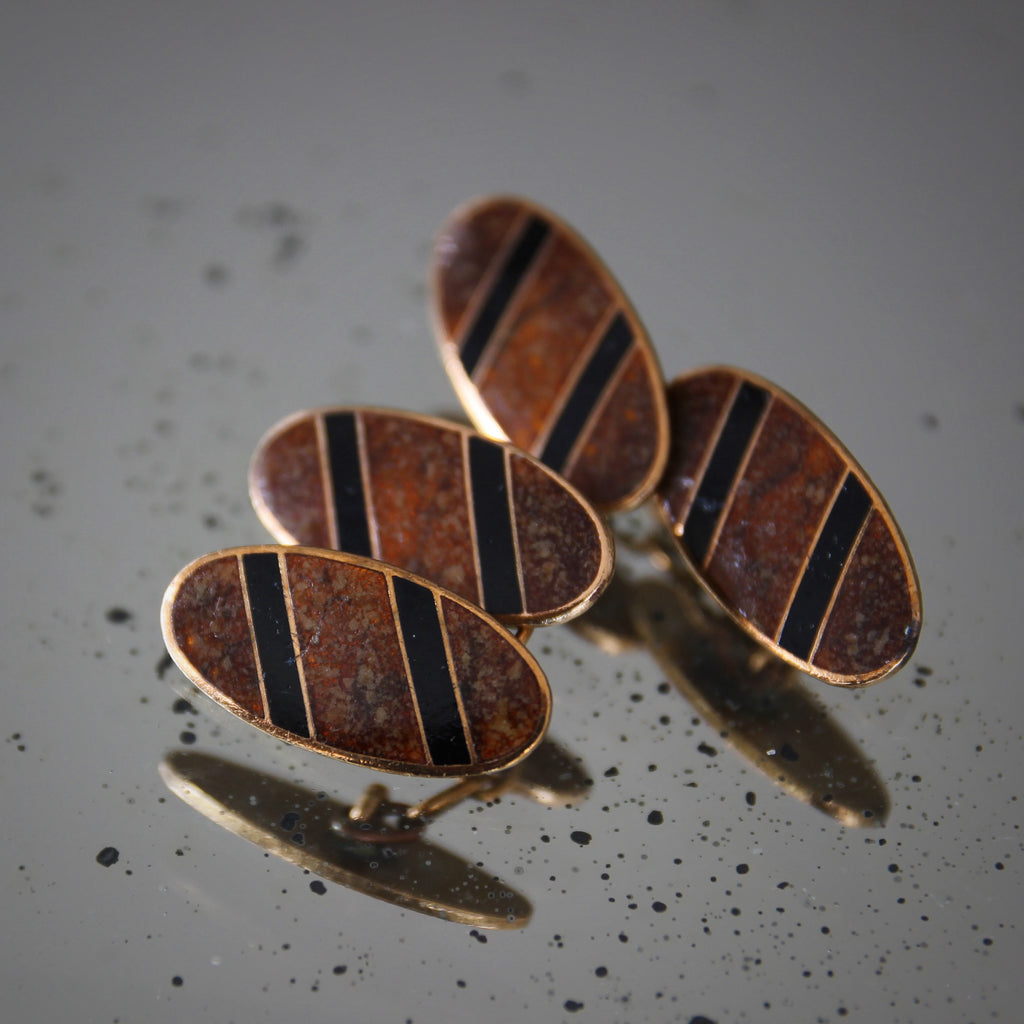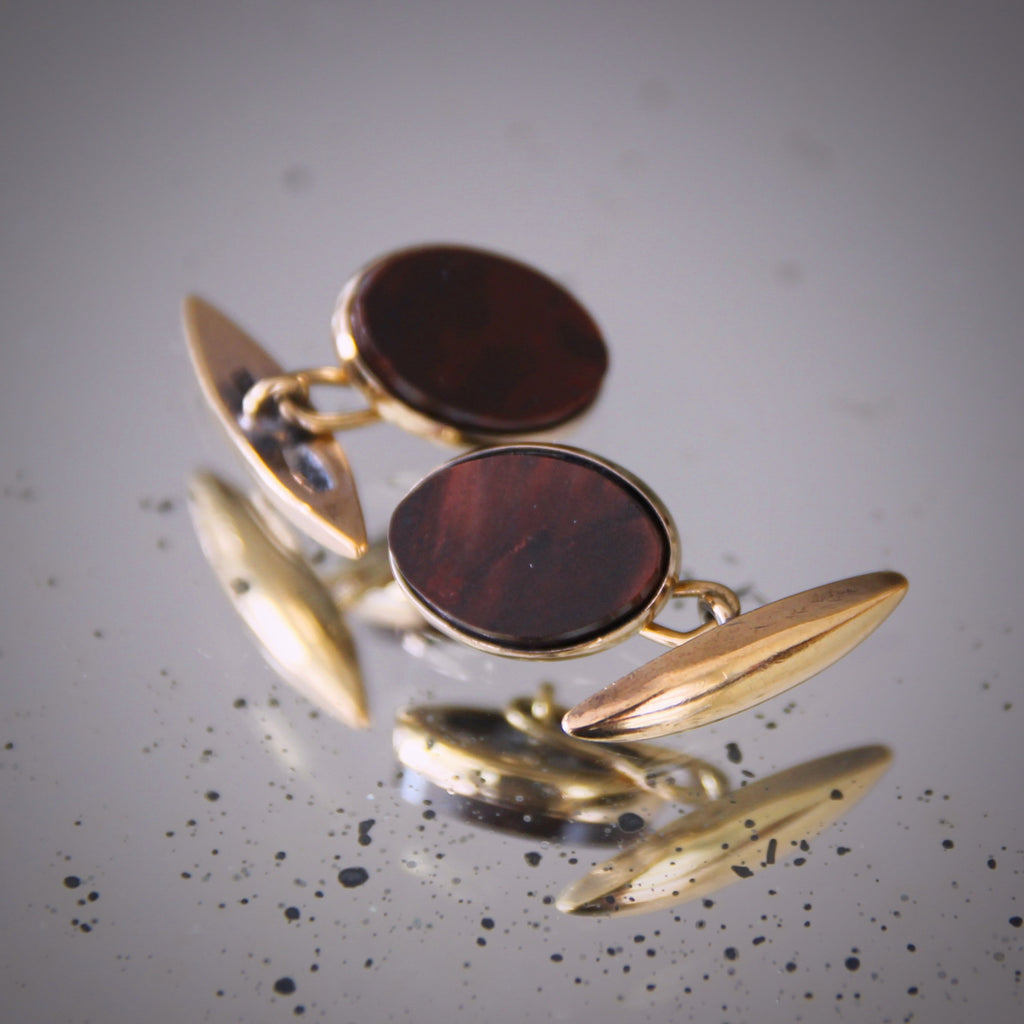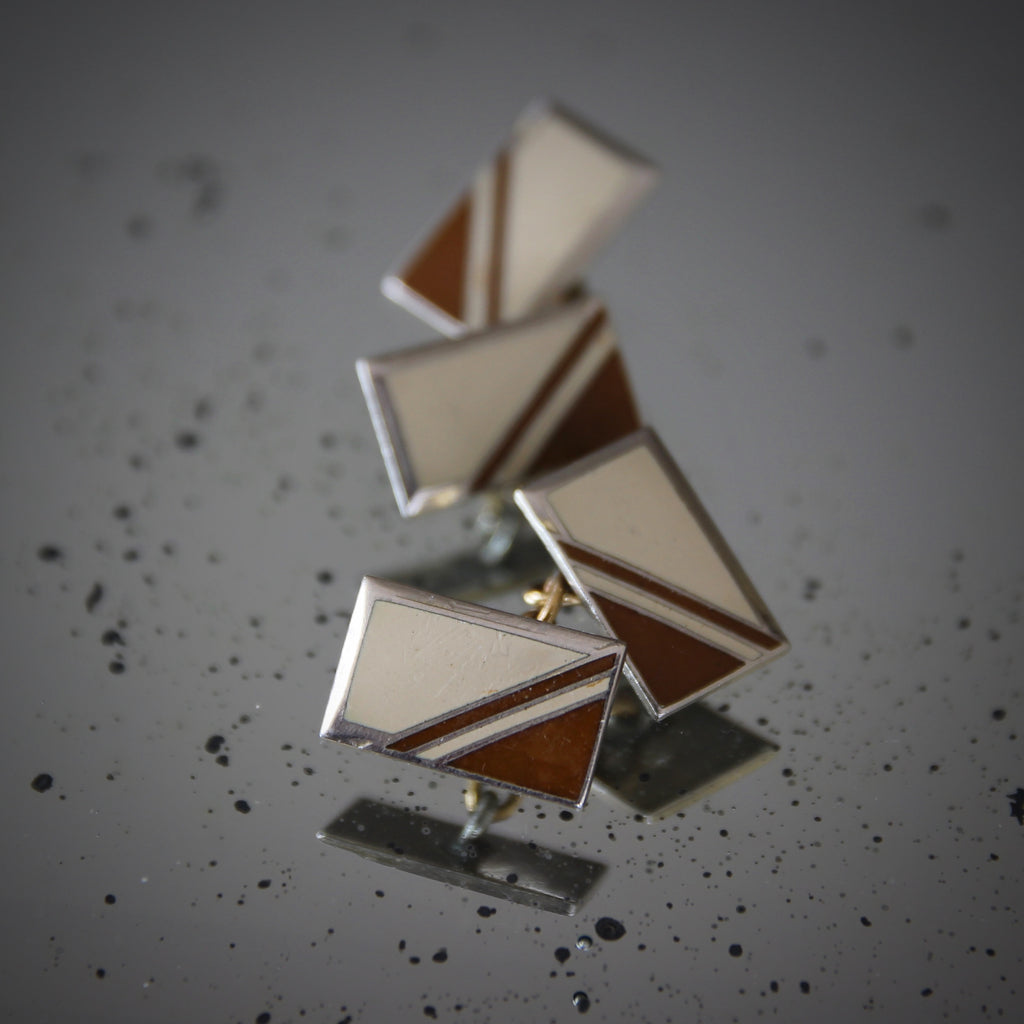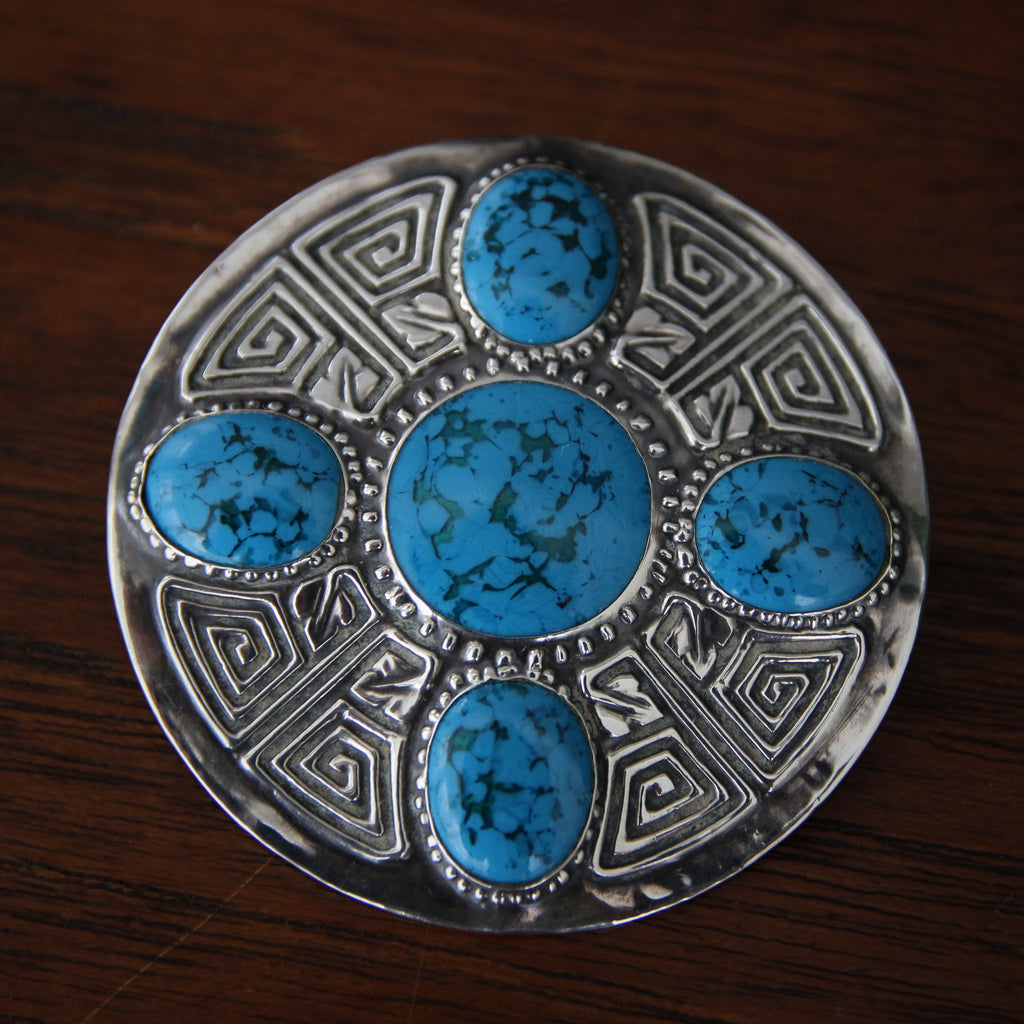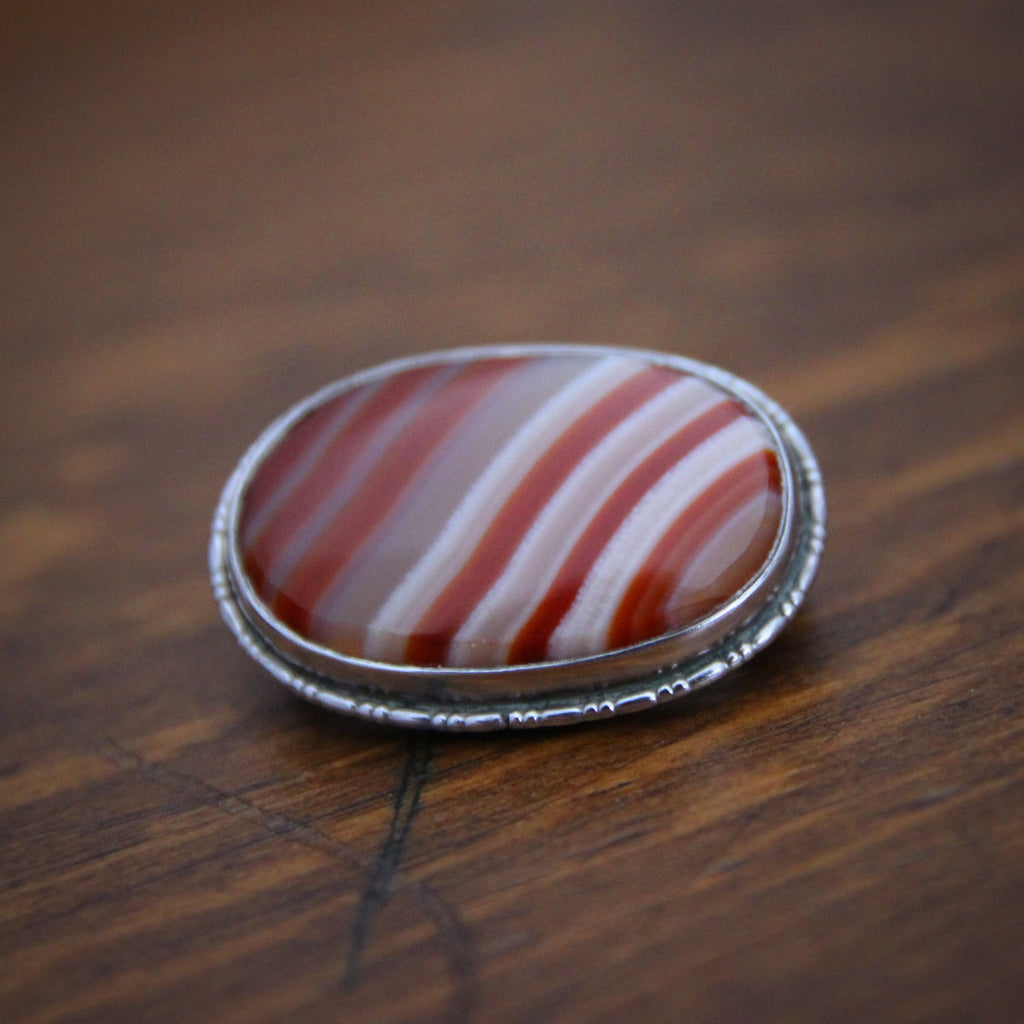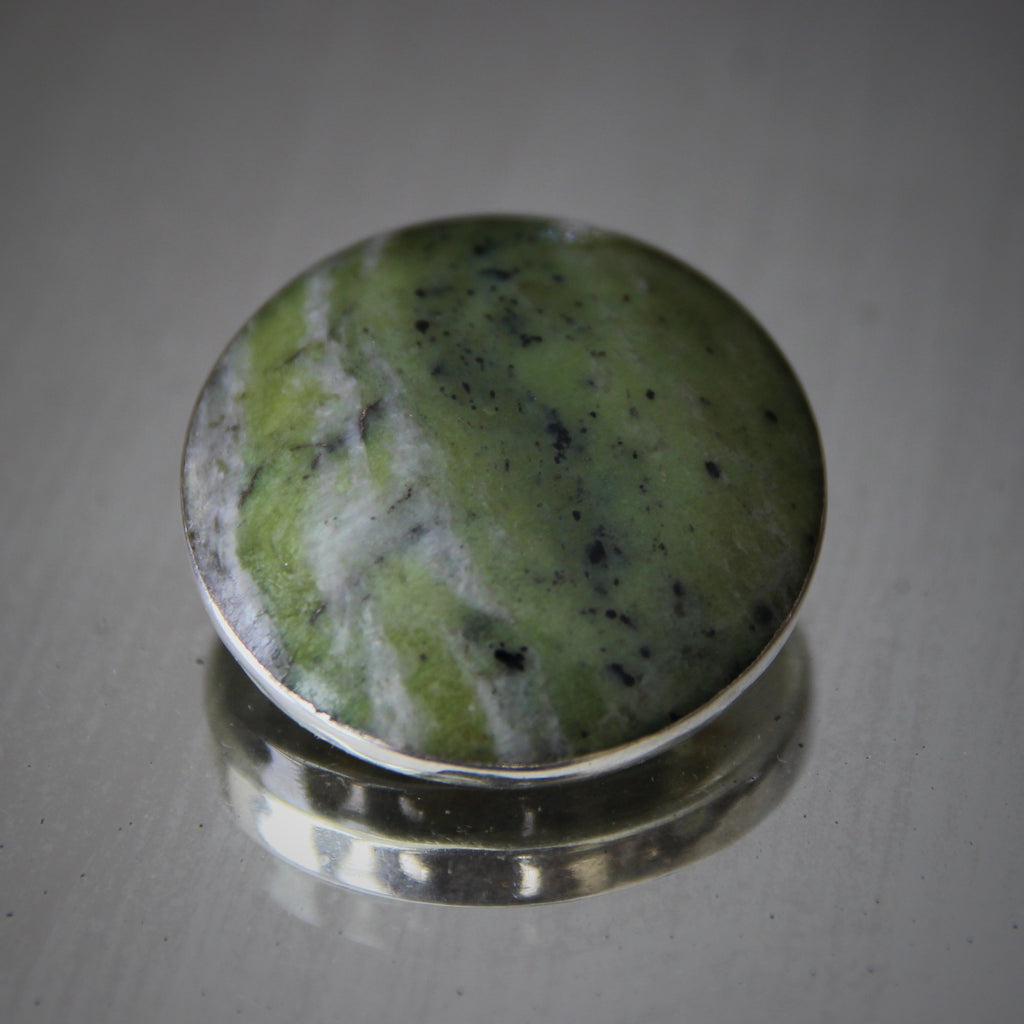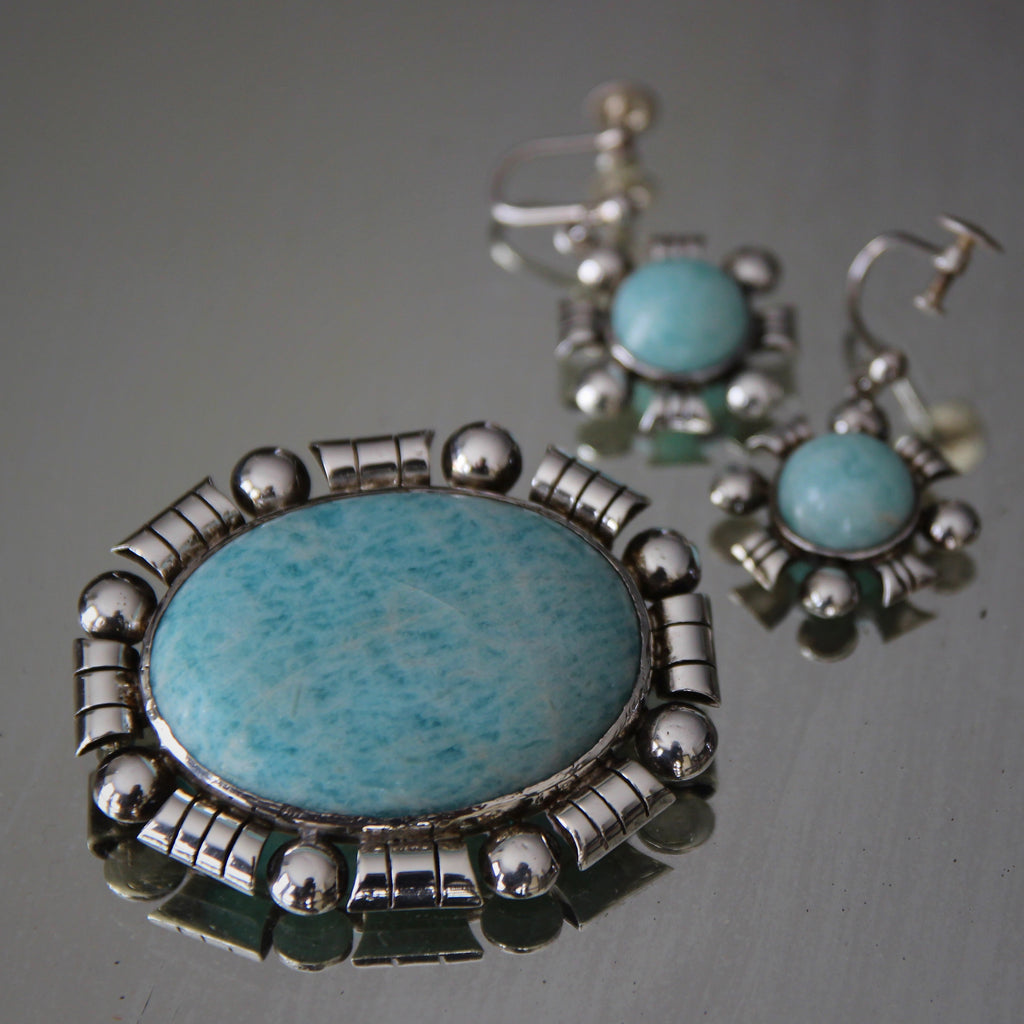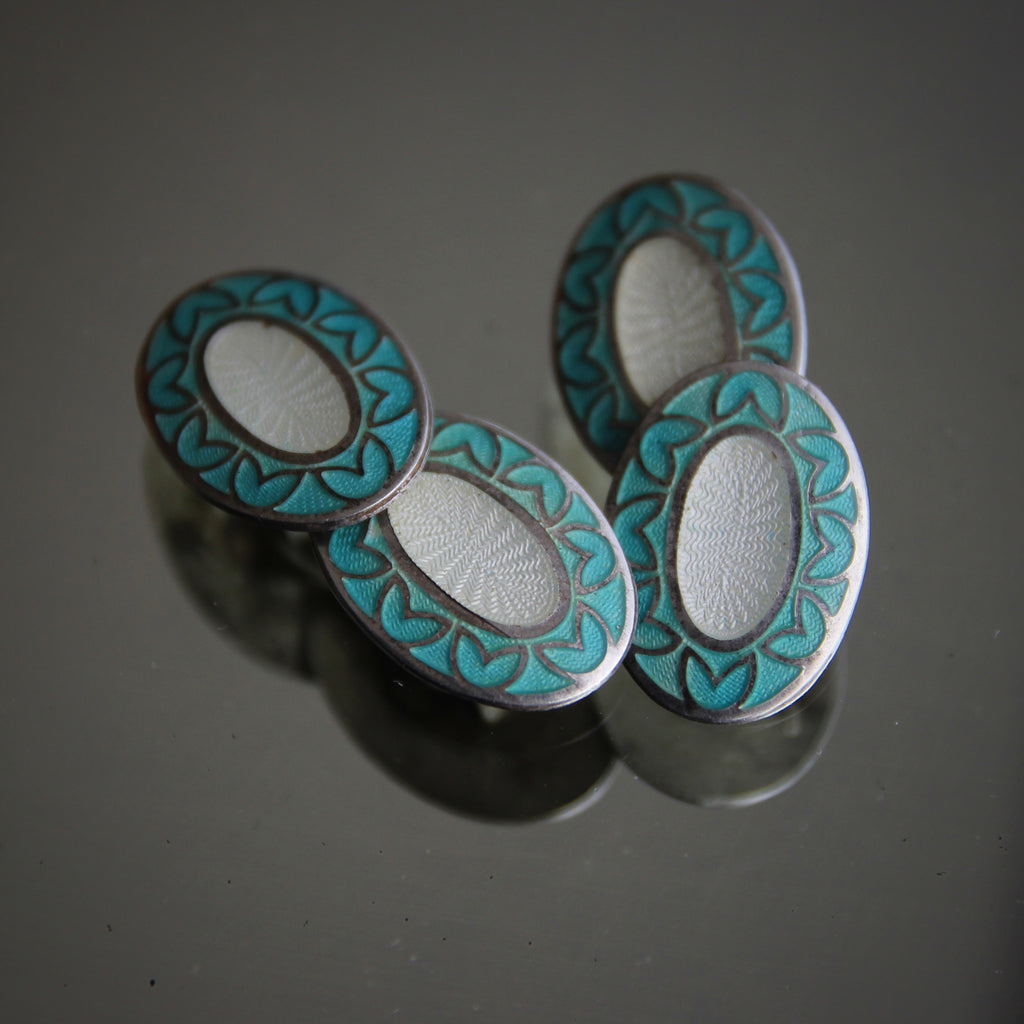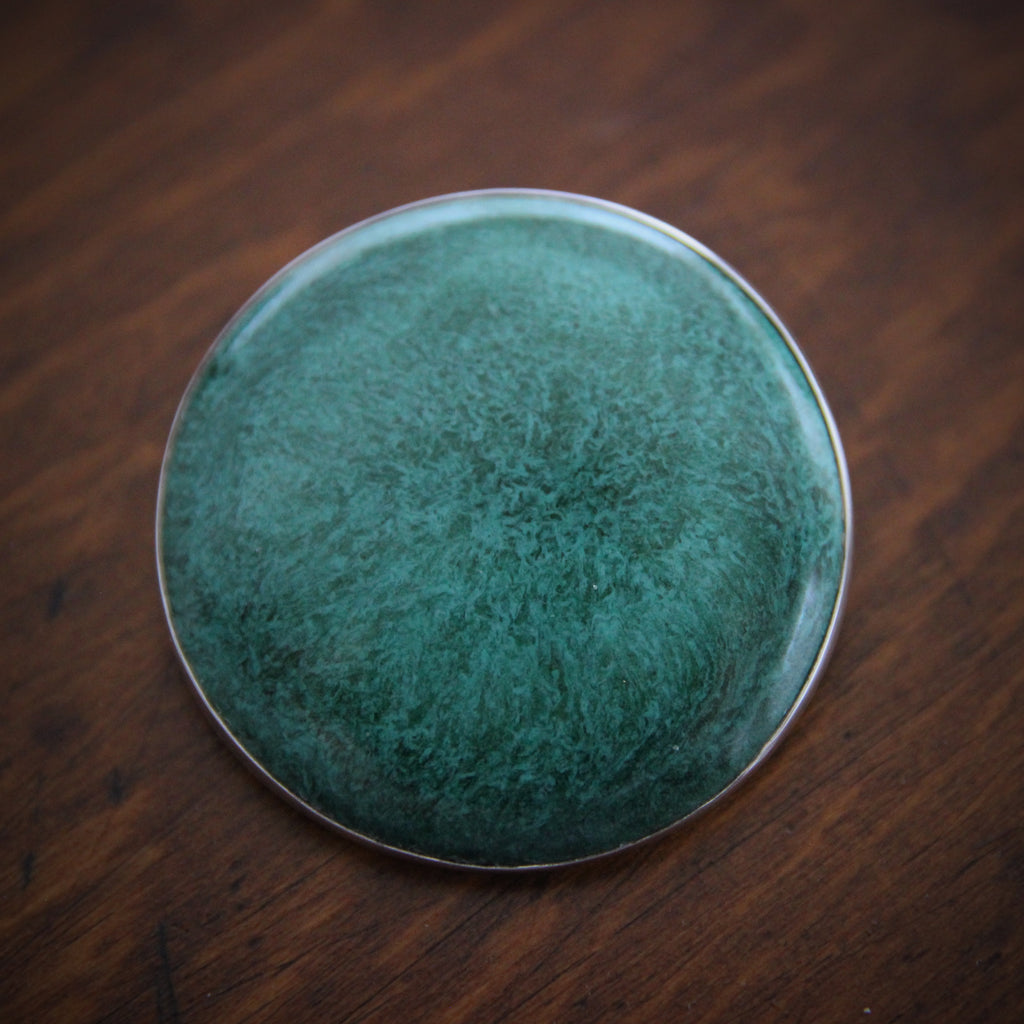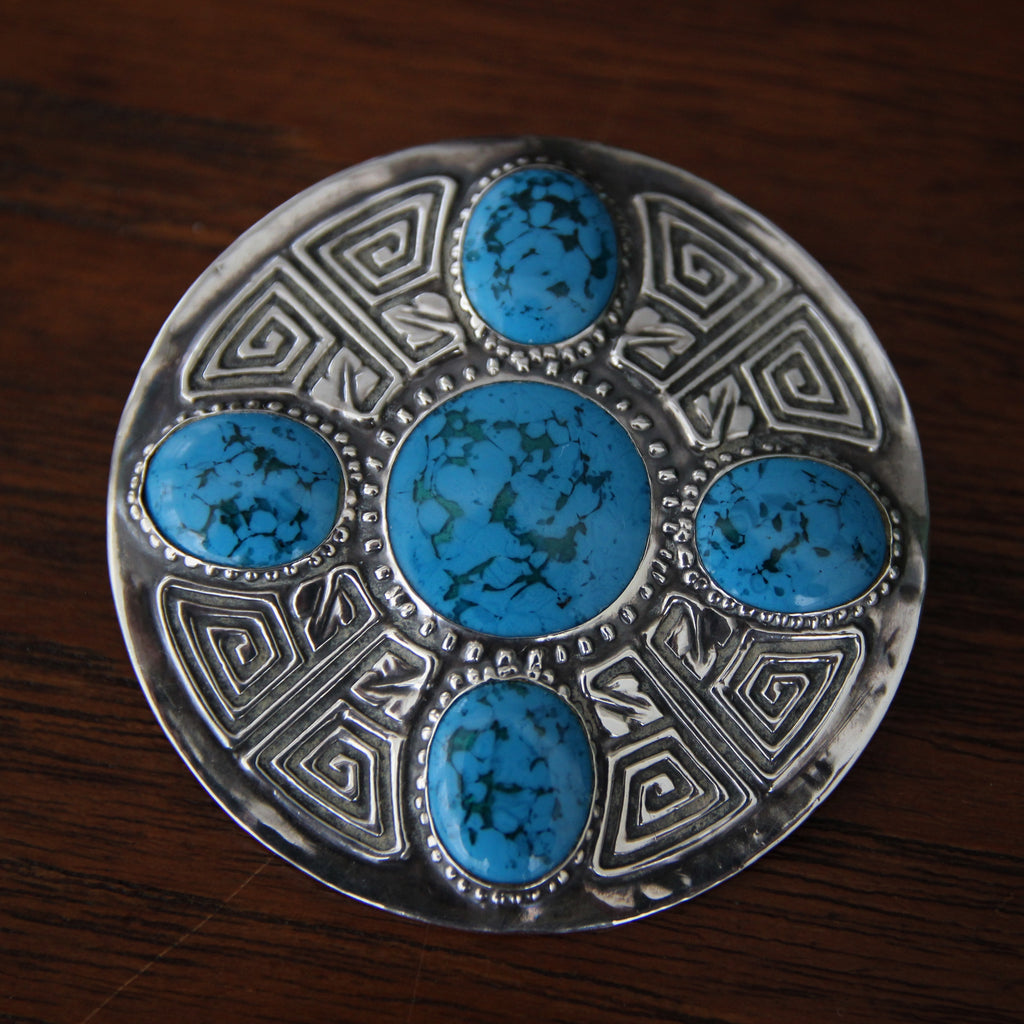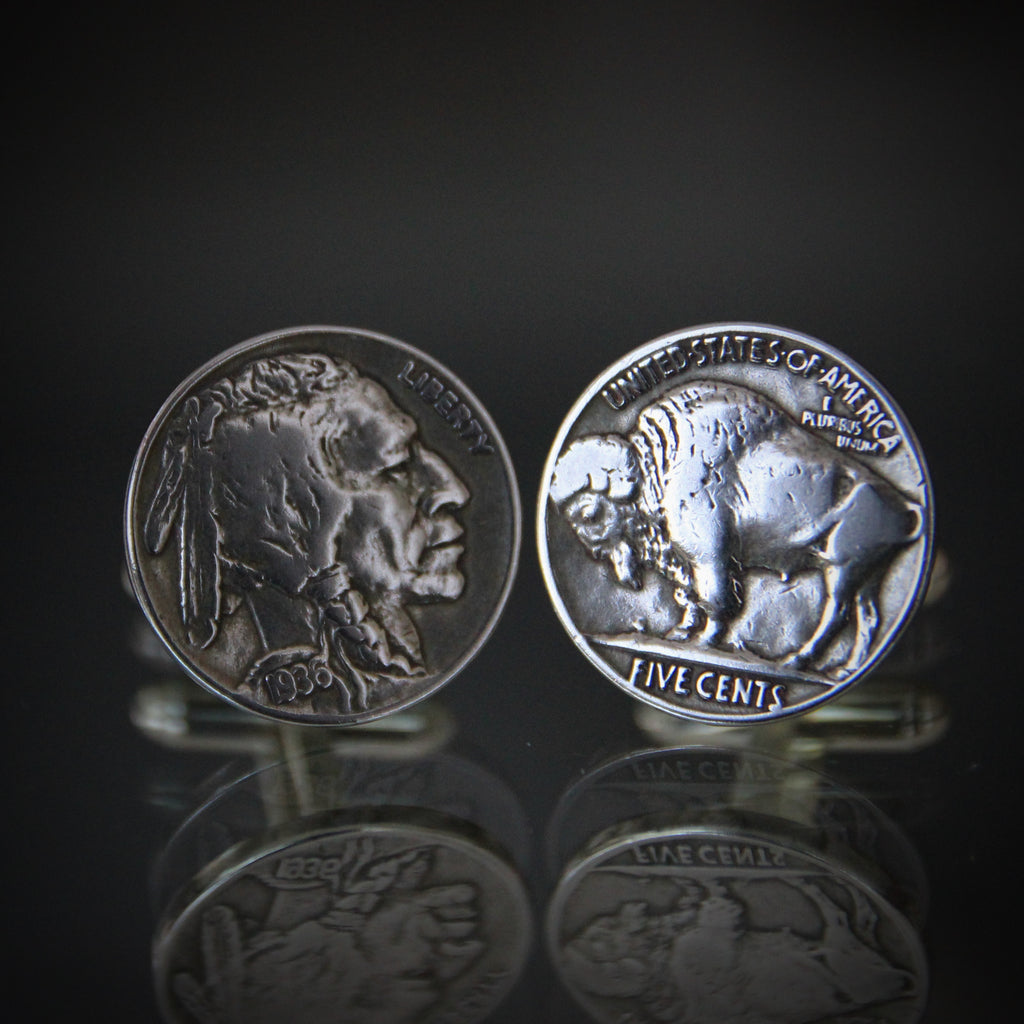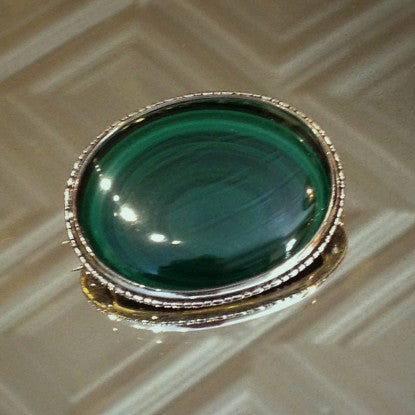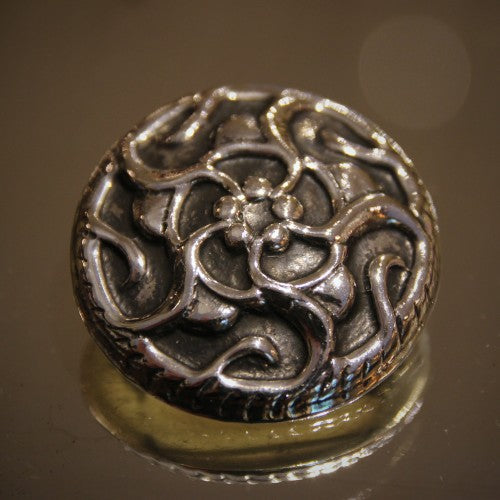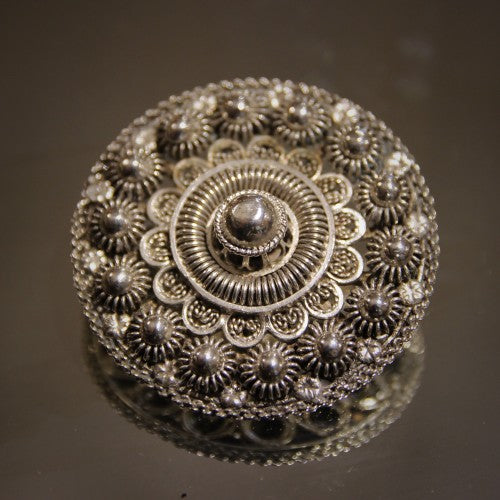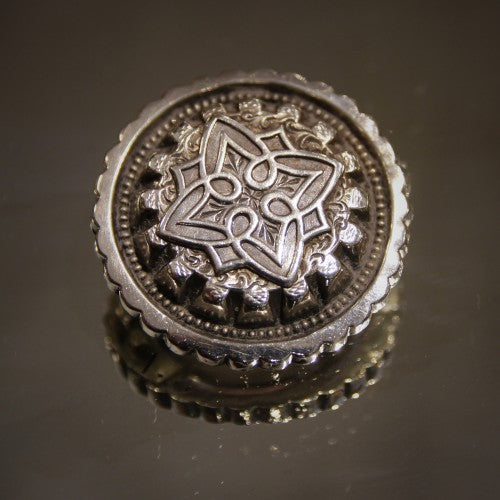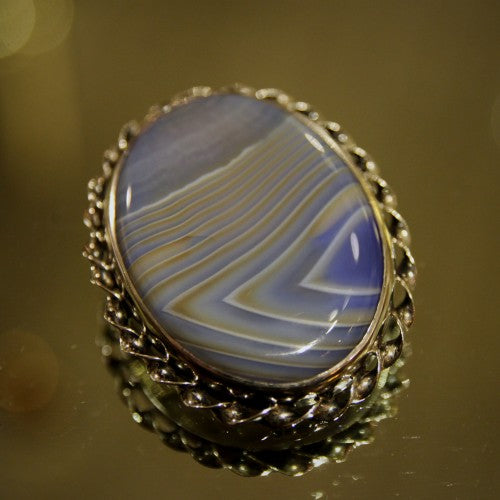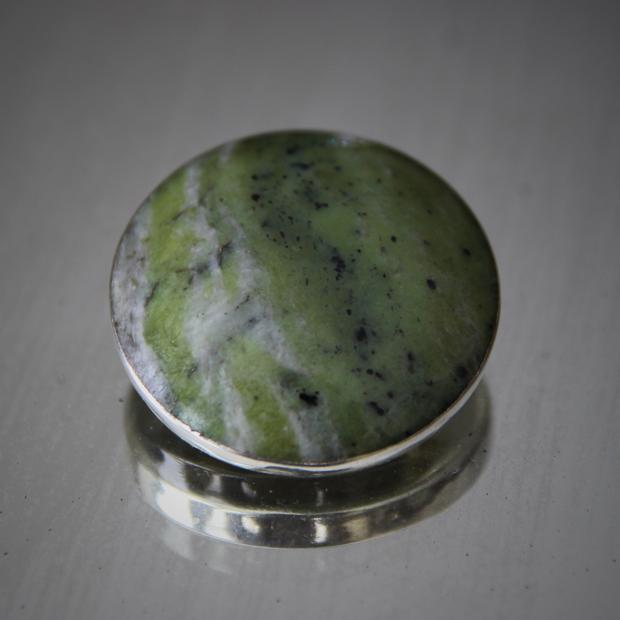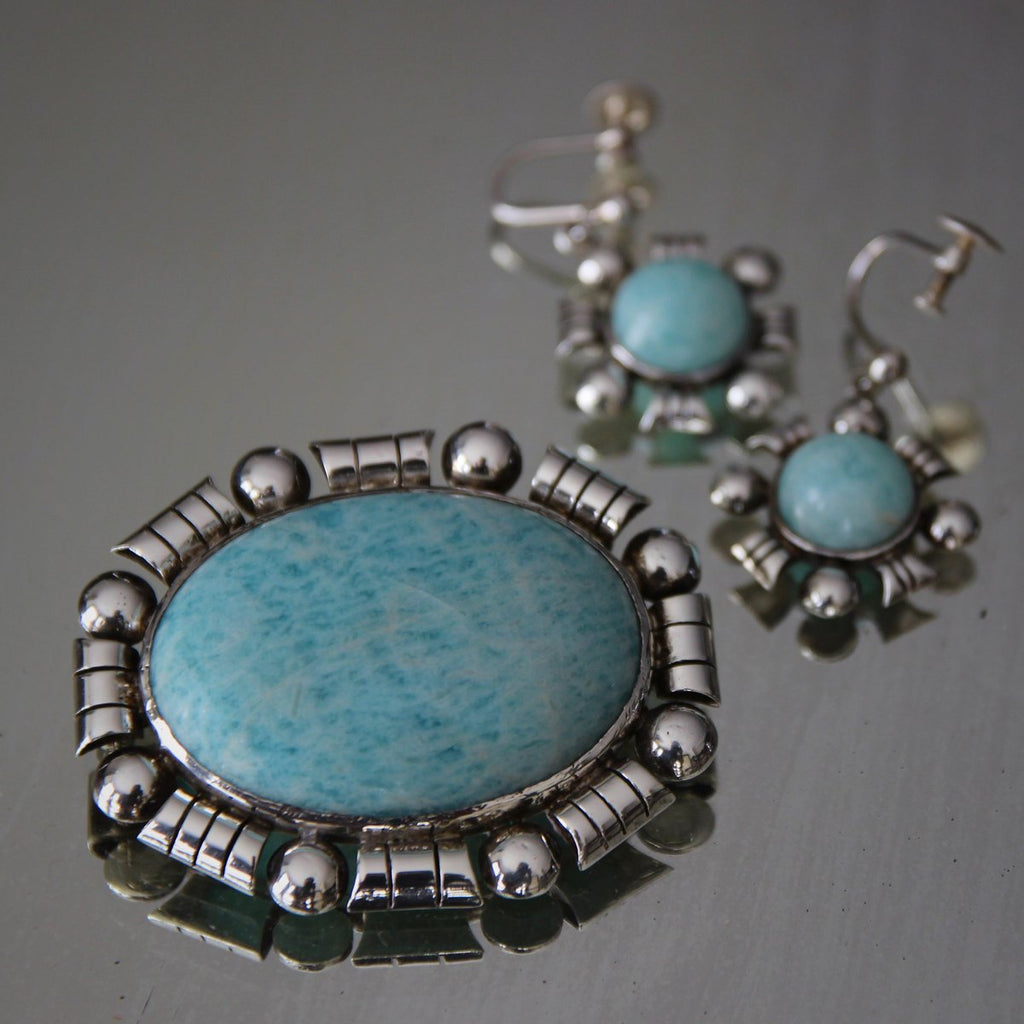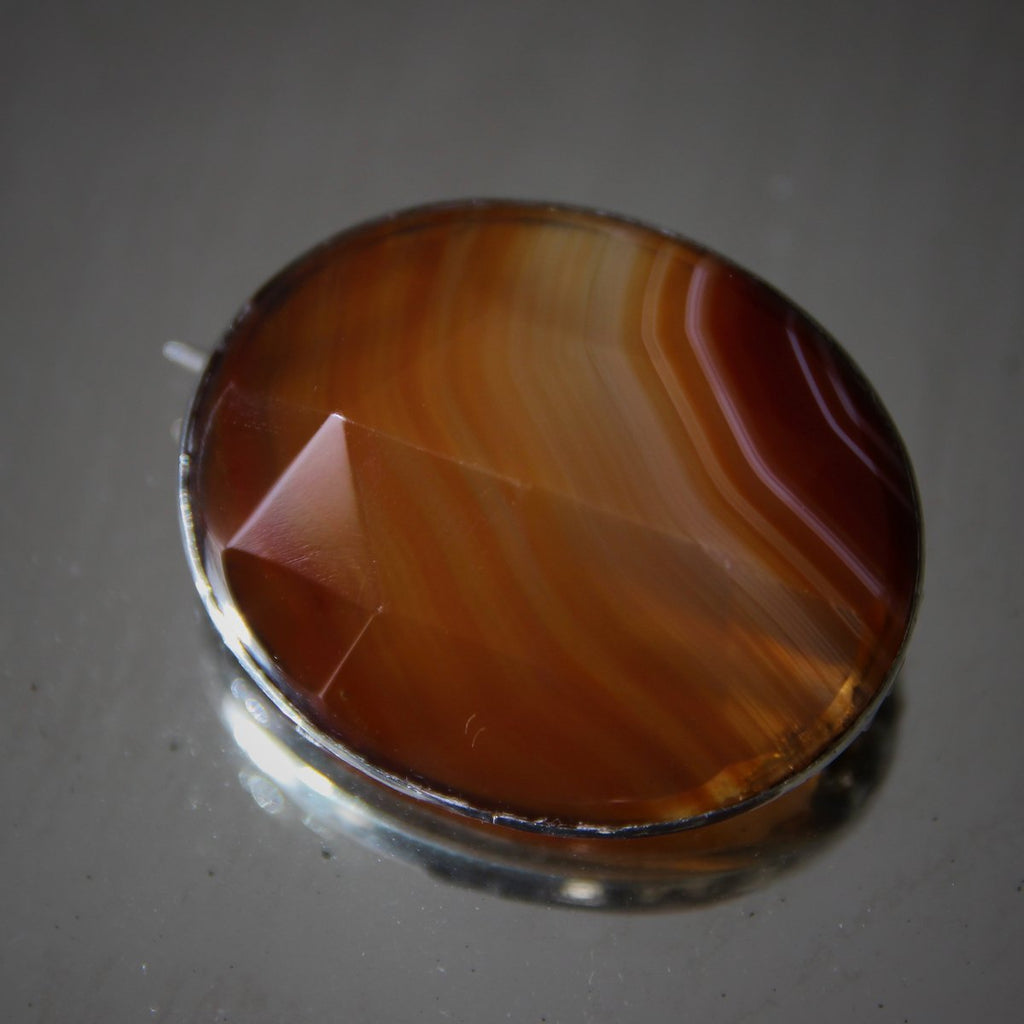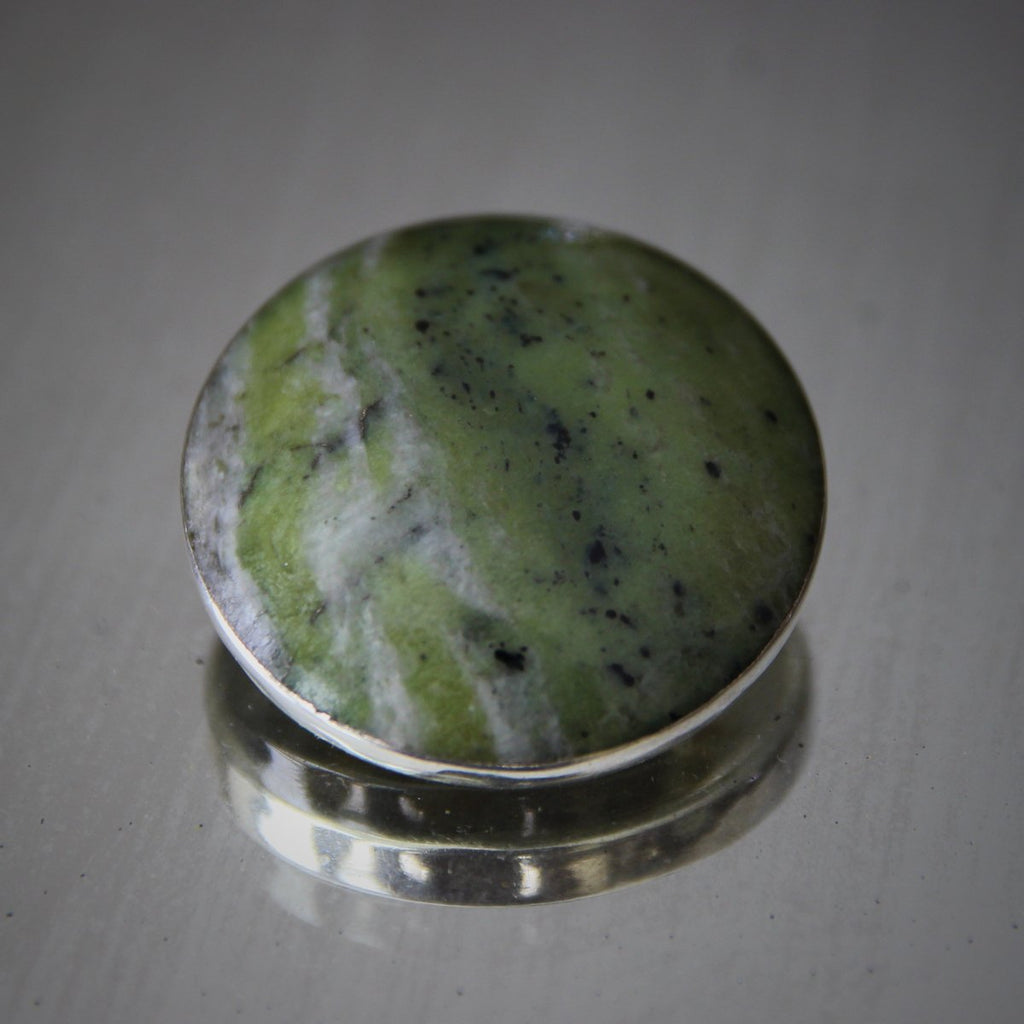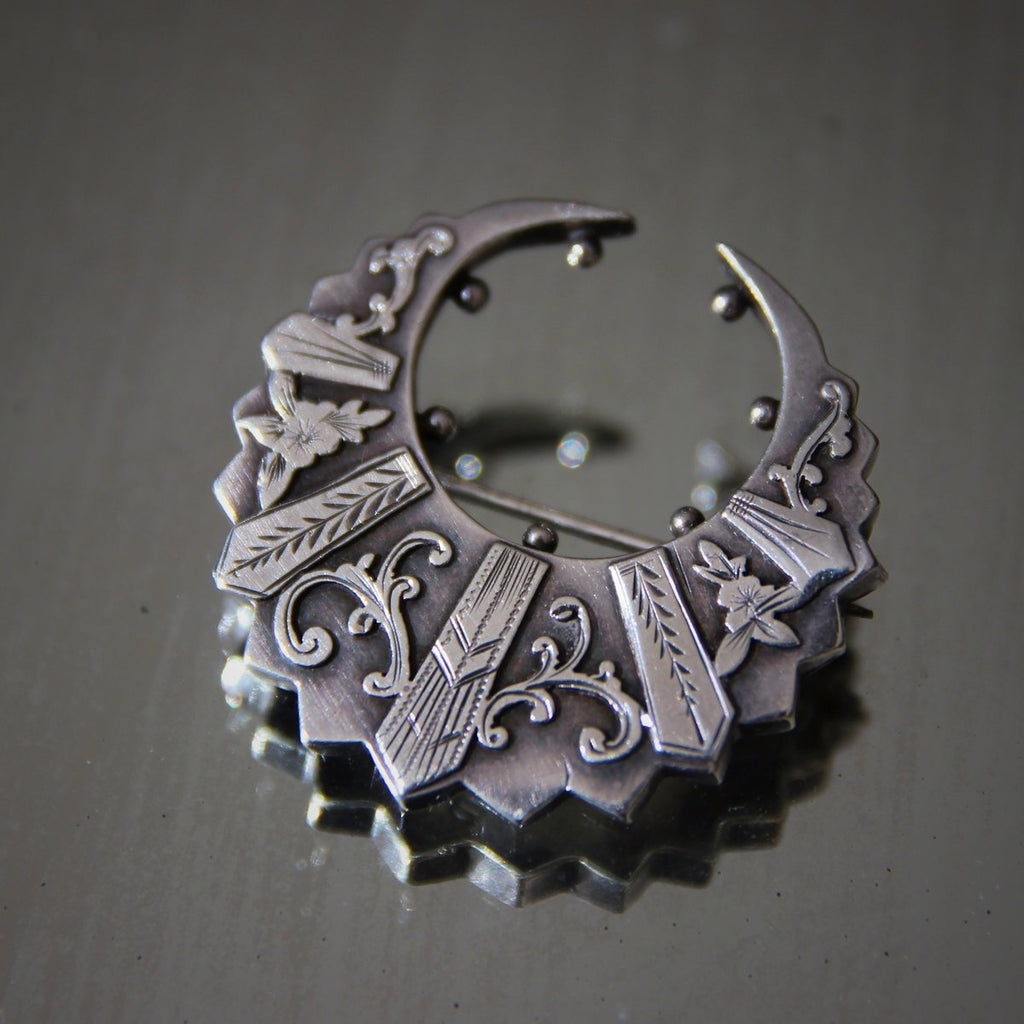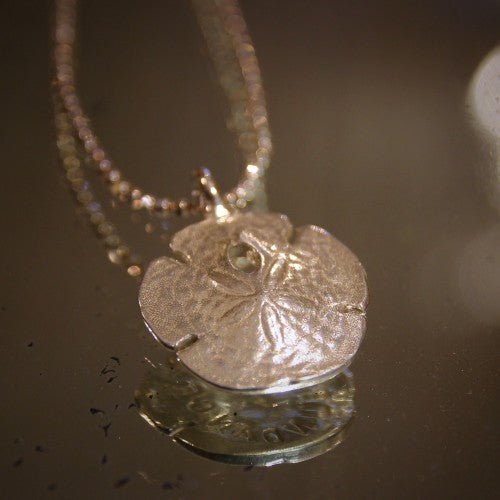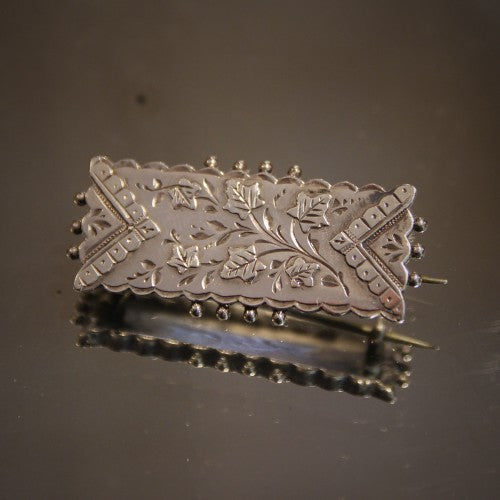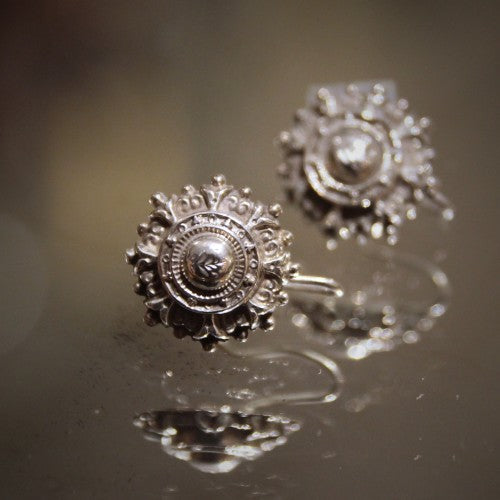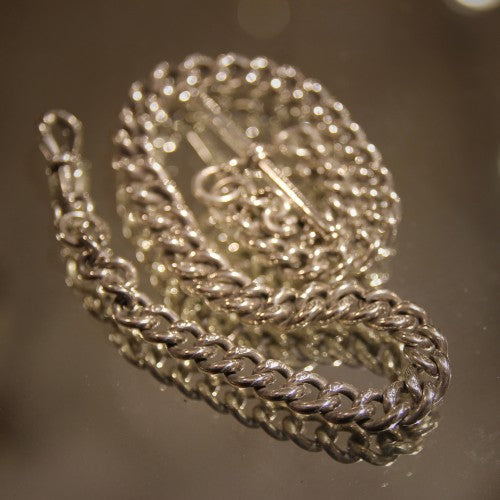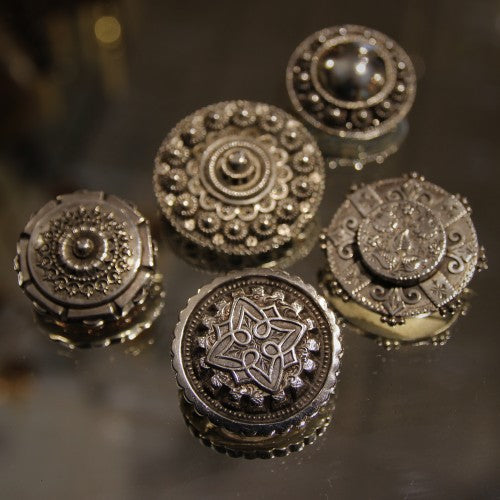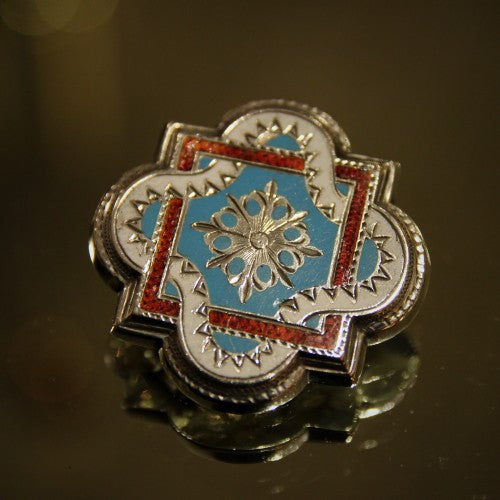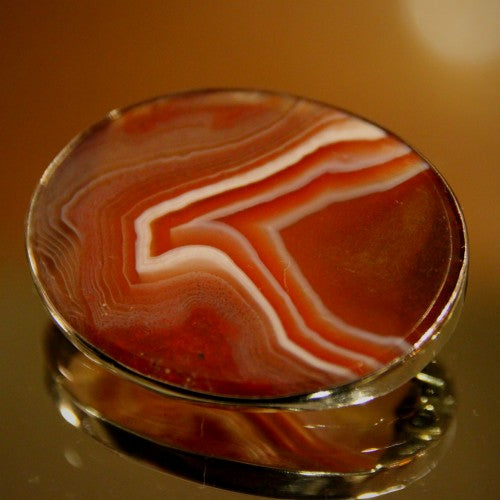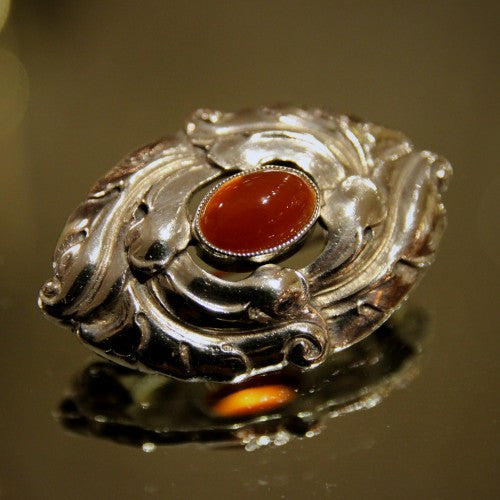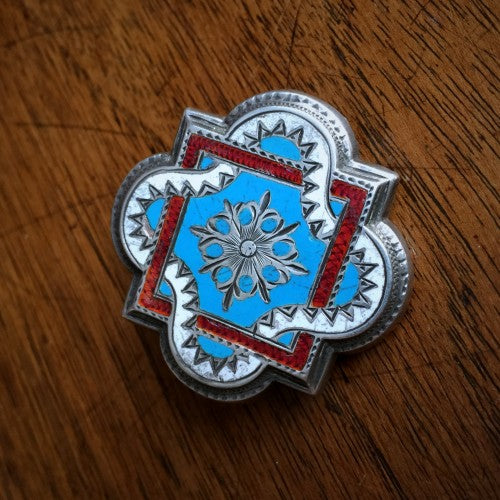JOURNAL — Jewelry RSS
For decades, I've been acquiring cufflinks for LEO Design—a big part of our collection of Handsome Gifts. But, one cannot hunt for men's jewelry without stumbling over (rather, wading through) lots of jewelry for women. In truth, 99% of jewelry I encounter was made for women. Therefore, as I unearth handsome cufflinks, I will see a lot of women's jewelry the process—and occasionally find an intriguing woman's piece which I cannot pass-up. True, the women's jewelry I acquire is usually more on the "Handsome Spectrum" rather than "The Frivolous." And the Norwegian Art Deco bracelet (circa 1920's-1930's), shown above, fits this description perfectly. It was made by David Andersen in Oslo (or, more accurately, by the workshop he founded in 1876,...
August's Sardonyx - VI
Handsome meets Lovely in this Scottish sardonyx and sterling silver brooch from the island of Iona. A bold striped cabochon-cut stone is set within a sliver Celtic scrolling botanical mounting. It was sent to Edinburgh in 1962 for hallmarking. The holy island of Iona has sustained a mystical prominence for centuries. Irish saint, Columba (521-597 AD), built a monastery on this windswept island in 563 AD. Today, Iona is one of the oldest continuously-operating religious locales in Western Europe and many Christians make pilgrimages to its Abbey each year. The island's calm, natural beauty, handcraft and religious history makes it a compelling place for Christian retreat and communal living. It was here that Celtic Christianity was established. The iconic carved...
August's Sardonyx - III
Here's another piece of sardonyx with a nicely restrained flourish. This Victorian Scottish brooch boasts a wide palette of warm reds—from dark russet to a translucent blush. But, to add a tasteful touch of sophisticated sparkle, the piece is faceted to gently catch and reflect the light. The piece is set within a silver mounting; made around 1890.
August's Sardonyx - I
Sardonyx is August's traditional birthstone. For the next few days, we'll be sharing some of our favorite sardonyx items, currently available for purchase in the LEO Design on-line shop. Each piece of sardonyx is unique—and each stone is further refashioned and adapted depending upon how the jeweler chooses to cut color, polish or mount each piece. Nature's random composition of color, striping and form is enhanced in the hands of a talented artisan. The Edwardian Scottish brooch, shown above, is rather understated at first glance. Varying shades of brown, tan and white form the striping, shot-through the stone millennia ago. Now, imagine seeing such a piece displayed on the lapel of a camel, buff, or winter white coat. It would...
August is Here
We welcome August—and her traditional birthstone, Sardonyx.
Sardonyx is irregularly "striped" with two different variations of Chalcedony: "Sard" (the blue portion shown here) and "Onyx" (the narrow bands in white). The range of possible natural colors is quite wide (including black and white) and, like onyx, the stone can be color-treated with heat or chemical washes (usually various acids) to amplify or change the stone's natural color.
In the antiques retail trade, sardonyx is sometimes casually called "agate." Agate and sardonyx are related—different varieties of chalcedony. Agate is usually softer than sardonyx and agate's bands are more irregular than the straight-ish lines found in sardonyx. Both sardonyx and agate are used decoratively, including in jewelry.
Stylish Silver - V
Filagree is a method of decorative metalwork involving the twisting and bending and soldering of wires (usually silver or gold), in order to fashion jewelry or other decorative metal objects. The delicate metalwork is often suggestive of lace. Sometimes silver or gold beads might by incorporated into the work The oldest filagree pieces date to 3000 BC and were found in Mesopotamia (modern day Iraq, Turkey, Syria and Kuwait). The Etruscans and Greeks adopted the art form and the work spread—mostly through trade and Arab migration—and could be found from Ireland to North Africa to Asia (especially India).
In the Medieval periods, filagree was used for jewelry, naturally, but also liturgical decor: reliquaries, processional crosses, croziers, gospel book covers.
Stylish Silver - IV
The village of Taxco, Mexico, has a long association with silver mining—and, more recently, silversmithing and jewelry-making. Since Pre-Columbian times, silver was mined here. In fact, an Aztec governor was placed in the old village of Taxco so that he could conveniently collect the "tributes" (of silver) payable (by the conquered subjects) to the Aztec ruler. When the Spaniards arrived, they modernized the silver mining—creating a "Silver Rush" in the Sixteenth Century which greatly enlarged the town's infrastructure. Taxco proved to be the biggest source of silver for the Spanish Empire. When the Mexican War of Independence (1820's and 1830's) expelled, killed or diminished the Spanish colonizers, most of the mines intentionally were closed-down as the Spaniards headed for the...
Stylish Silver - III
This Victorian English silver brooch, hallmarked Chester, 1887, is as much sculpture as it is jewelry. The deep crescent is laid-on with hand-engraved strap work, further embellished with scrolling botanical elements. The jagged perimeter adds an additional jolt of energy to the silhouette.
Whenever I've asked a British antiques trader to identify one of their hallmarks, they always seem to let out a bittersweet, "Oh, it's Chester..." upon discovering that city's chevron-shield hallmark bearing three wheat sheaves. Apparently, the assay (hallmarking) office in this charming city closed in 1962. To this day, English antiques dealers seem to fondly reminisce about this little town, near the Wales border (whether they have ever been there or not).
Stylish Silver - II
This week we are sharing some of our favorite silver brooches—designs which are enhanced by their precious metal composition (not overwhelmed by it).
Shown here, a Victorian English silver brooch with a whimsical Celtic correlate design—sitting atop an otherwise serious base.
Stylish Silver - I
Silver is an "element"—that is, a pure chemical substance which cannot be broken-down further into simpler components. And silver straddles a special place in the hierarchy of "metal preciousness." While it is not a "common" metal (like copper or brass or pewter or bronze), neither is it as precious as gold or platinum. To my eye (and my mind), items crafted of gold—no matter how beautiful—cannot escape their status as . . . well . . . gold. To me, their material composition often dictates their appraisal—visually and intellectually. I truly love all those non-precious "craft" metals—the metals (or alloys) fashioned by artists to create decorative objects (by sculpting, hammering or casting). Their earthy honesty is raised to decorative status...
Feeling Blue - VIII
Agate stones are popular throughout Britain—no more so than in Scotland. The natural "layering"—irregular stripes of stratification—build-up over centuries of time, heat and pressure. Once polished, no two pieces are ever exactly the same. Furthermore, for centuries gemologists have been dying agate to create different, pleasing color combinations.
The English brooch, shown above, was made in London. The sterling silver mounting is hallmarked London 1987. While that might not seem very old, rest assured that the agate stone itself is millions of years old (and looking better than ever).
Farewell, Duncan
On this day in 1040 AD, Macbeth's army killed Scots King Duncan I. Macbeth held the Scottish throne for the next 17 years.
Duncan—known in Scots Celtic as Donnchadh mac Crìonain—is represented in Shakespeare's tragic play, Macbeth (1606), as an older man. In fact, King Duncan (1001-1040) was crowned at 33 and died at the tender age of 39. He did have at least two sons, both of whom also appear in the play: Máel Coluim Mac Donnchadh (Malcolm) and Domnall Bán (Donalbain). Macbeth was cousin to King Duncan and a duke, as well.
August is Here
It's August! Thus, let's welcome the month's birthstone, Sardonyx. Sardonyx is "striped" with random bands of two different variations of chalcedony: "Sard" (the reddish portion shown here) and "Onyx" (which is shown above in white). The range of possible natural colors is quite wide (including black and white) and, like onyx, the stone can be color-treated with heat or chemical washes (usually various acids) to amplify or change the stone's natural color. In the antiques retail trade, sardonyx is sometimes casually called "agate." Agate and sardonyx, though related, are differing varieties of chalcedony. Agate is usually softer than sardonyx and agate's bands are more irregular than the straight-ish lines found in sardonyx. Both stones, sardonyx and agate, are used...
Handsome and Useful
The earliest known reference to a pocket watch was in the mid 1400's—though (for many centuries after that) they were strictly the province of the wealthy. In the Nineteenth Century, improved mass production made pocket watches more affordable and, thus, more common. Now the middle class (and the professional working class) could afford to buy such a convenience. Additionally, it was in the second half of the Nineteenth Century that time became increasingly standardized, that is, unified into larger zones across states and counties (mostly to accommodate the boom in railway scheduling). Prior to this standardization, every village might have its own time zone, based on the local town square clock. It was during World War One that wrist watches...
Memorial Day
Today we commemorate, honor and express gratitude to those Americans who died in service to our country. In the period immediately following the American Civil War (and, some argue, even before that), states and local jurisdictions celebrated the holiday in various and individual ways. These days became known as Decoration Day—a day reserved for cleaning and decorating the graves of fallen soldiers. On 30 May 1868, the first national Memorial Day was celebrated; the national commemoration was observed on every 30 May for the next century. In 1971, Congress moved the national holiday to the last Monday of May (to regularize the celebration with a three day weekend).
Bevy of Brooches - IV
People who follow my journal writings know that I repeat often the founding precepts of the Arts & Crafts Movement. One such tenet was the "revival" of ancient cultural elements—aesthetic, historical or literary references which had resonance for the people in that community, at that time. Another principle was the elevation of beautiful, common materials to the aesthetic equal of more precious elements. This English Arts & Crafts brooch ticks both of these boxes.
The brooch shown here was made in the very early Twentieth Century. Its silver-fronted face is embellished with meandering, Celtic-inspired graphics. Set within the brooch's face are five art glass cabochons—crafted with the appearance of Persian Turquoise.
Bevy of Brooches - III
Queen Victoria's beloved husband, Prince Albert, died in 1861. The Queen still had four decades left in her reign—a long period during which she remained in-mourning. Queen Victoria wore black every day for the rest of her life. And while her jewelry needed to be attractive, it also had to be appropriately understated—if not melancholy. The Queen set the fashion for the rest of the nation; for forty years, the entire nation observed some measure of mourning alongside their Queen. Thus, the English jewelry from the last third of the Nineteenth Century tended to be stately, serious and handsome—not whimsical, sunny or frivolous.
Bevy of Brooches - II
Simply put, a "cabochon" is a plain, domed "stone"—without faceting—which is rounded and polished on the top and (usually) flat on the bottom. The term refers mostly to gemstones, shaped this way to be mounted into jewelry. But, during the Arts & Crafts period, craftsmen made cabochons out of glass or glazed ceramic to be used as decorative elements (embedded in metalwork or woodwork). One of the aims of the Arts & Crafts Movement was to elevate the beauty of simple materials. In this case, a beautifully glazed, hand-crafted ceramic rondel could be appreciated as much as an expensive, precious gemstone.
Bevy of Brooches - I
When I travel on buying trips, I am always looking for nice cufflinks and other masculine jewelry. But I am unable to avoid crossing paths with lots of women's jewelry. In fact, most jewelry dealers carry far more women's jewelry than men's jewelry. Given this reality, I frequently find myself picking-up some nice pieces for women. But my taste leans to the "handsome" more than the "girly". When I do buy a piece of women's jewelry, it tends to reflect a more robust taste: a bit heavy, a bit stoney, a bit serious, a bit dour. Late Nineteenth Century—Victorian Mourning Jewelry—always appeals to me. But I do try to step-out of my little lane, every now and then.
98 Years Ago Today
98 years ago today . . . this chauffeur's badge expired. The copper badge—to be worn in the hat of a New York chauffeur—was issued in 1923 and it expired on 1 July 1924.
New York required professional drivers to be licensed. A distinction was made between a chauffeur and a "hack" (from the British term "hackney driver"—a throwback to the days of horse-drawn carriages for hire). A licensed chauffeur might drive for a single private client or for the owner of a company with a fleet of cars. Chauffeurs were trained to drive safely, defensively, and were expected to offer a higher level of customer service and elegance in their deportment.
Countdown to Mother's Day - VIII
While on the hunt for men's jewelry, mostly cufflinks, I will often come-across women's jewelry which catches my eye—most often jewelry which might be called "handsome." (By the way, "handsome" was a term used to describe attractively stately women in the 19th Century. It did not carry a male-only connotation.) These pieces usually exhibit interesting metalwork or attractive semi-precious stones and would rarely be called "girly" or "fussy." Strong, bold and organic pieces are most likely to appeal to me. One such brooch is shown above: an English polished oval agate with randomly organic striations of blue, white and honey-caramel. The stone is set in a "twisted" sterling silver mounting, hallmarked London 1987. While the setting is not very old, the stone itself has...
Countdown to Mother's Day - II
After Prince Albert died in 1861, Queen Victoria still had four decades left on the British throne. The Queen remained in-mourning throughout that long period, modifying her dress and adornment to suit her situation as a grieving widow. The Queen was also an important role model and taste-maker for the nation; her choices inevitably affected the mood, dress and comportment of her people. While not every piece of jewelry made during that time period could be called "mourning jewelry," simple, handsome and serious design remained popular through the end of the Nineteenth Century (and the Queen's lifetime). Frivolity was out. Sober was in. Luckily for me, I am fond of such heavy and handsome jewelry. And many of my female...
It's Mourning in England
When I hunt for jewelry, I mostly seek cufflinks—from the Victorian to the Art Deco Period. But I will frequently stumble across a piece of women's jewelry that I cannot pass-up. These pieces often feature interesting stones, heavy metal work and bold designs. More "handsome" than "girlie." Some of my favorite pieces are known as "Mourning Jewelry" from Victorian England. Mourning jewelry was not invented by the Victorians; it had been crafted and worn since the Medieval Era. But, with the death of Prince Albert in 1861, Queen Victoria began a 40 year period of mourning—and took her country along with her (at least for part of that time). Whitby jet, from Yorkshire, became popular. It was black, shiny and...
Fall Back
Set-back your clocks (one hour) tonight before bedtime. Daylight Savings Time ends in the wee hours of Sunday morning. Twice a year (that is, whenever we switch the clocks), the controversy is revived: should we even continue using Daylight Savings Time? The semi-annual arguments provide plenty of heat, though very little light (pardon the pun). One-third of Americans want to stick to Standard Time year 'round. One-third of Americans want to stick to Daylight Savings Time year 'round. And one-third of Americans either don't know or don't care. My conclusion: all three options have serious downsides. Personally, I can live with the changes of the clock, knowing that I will benefit from more light in Summer evenings and more...
Just a Little Fun
When Queen Victoria's beloved husband, Prince Albert, died in 1861, Victoria (and the entire British Empire) went into mourning—an expression which manifested itself in fashion, jewelry and the decorative arts. Victoria remained in mourning for the rest of her life—forty years of black clothing and heavy, sombre jewelry (nothing frivolous or too jolly). This four-decades-long period of sobriety had a tremendous impact on the aesthetics of the day. Personally, I have always liked the heavy and serious, but handsome decorations of the day, mourning jewelry included.
Serious Charm
Tangible items accrue even more relevance during times of drama, uncertainty or an encounter with life-and-death anxiety. A simple token can become an emotional lifeline when one's beloved is in peril—and may never return alive. Such was the case for hundreds of millions of people—spouses, children, parents and friends—who sent a loved one (usually a young man) off to fight in World War One. 70 million soldiers fought. 10 million soldiers died (alongside another 10 million civilians killed). 20 million people sustained serious physical injury. And we are still coming to terms with the extent of the emotional trauma the war inflicted. This French "Sweetheart Bracelet" might have been given by a young soldier to his girlfriend or wife. It is a collection...
Vive la France
Today is Bastille Day—called Fête nationale in French—the annual celebration commemorating the Storming of the Bastille in 1789. The Bastille was a fortress in Paris in which political enemies were sometimes held—often unjustly and simply at the whim of the King. The Storming of the Bastille, during which some of the King's political prisoners were liberated, is a major landmark in the French Revolution, a struggle which ended the country's monarchy. 14 July is still celebrated today as one of France's most important "historic" holidays, perhaps comparable to 4 July in the States. There are parties, parades, a great deal of pageantry and showy displays of military power. And lots of Red, White and Blue. Another treasured symbol of those who fought for Liberté, egalité...
Perfect with a Tan
If you must dress-up during the summer, why not take advantage of the season? Imagine this handsome pair of English Art Deco cufflinks, fastening a crisp, light-blue shirt, against a perfectly summer-tanned wrist. The mother-of-pearl irises will certainly "pop" while the blue tone of the surrounding color will be pulled forward. And the golden settings will certainly add its own measure of summer warmth.
More Stately Charm
Here's another handsome brooch, this time Scottish. It features a polished banded agate cabochon in multiple shades of browns and whites. It is set into a silver mount, lapel pin attached. It has almost an "abstract expressionist" sensibility—remarkable considering that the stone itself may be a million years old.
Creamy, Dreamy
I don't really go-out on the hunt for women's jewelry very often. But, while I'm searching for cufflinks, I sometimes come across a handsome piece of women's jewelry (often Victorian or Edwardian) that really speaks to me. No one would accuse me of selecting "girly" pieces. In fact, there is often a "stately handsomeness" to the pieces of women's jewelry I collect. This usually means serious (perhaps solemn) stonework and metalwork that revives the Gothic. Queen Victoria spent almost 40 years of her reign as a widow, and she wore dark and heavy mourning wear from her husband's passing in 1861 until her death in 1901. She set the fashion trends for her fellow countrywomen, especially the aristocracy. Thus, luckily for...
Welcome, June!
The birthstone for the month of June is not a "stone" at all. It is the pearl—the mysterious and exotic and (at one time) ultra-rare treasure from the seas. Pearls, which represent purity, innocence and humility, were once the most precious of all the jewels. Egyptian aristocrats would be buried with their pearls. The Ancient Greeks believed that pearls were the tears of the gods. The Bible tells of the wise merchant who would sell all his stock in order to acquire one perfect pearl. And "pearls before swine" is a classic metaphor for wasting something on a person who cannot understand or appreciate it. Even the Gates of Heaven are encrusted with pearls—"The Pearly Gates." The famous American gemologist...
Accessories for the Natural Man - XVIII
An understated white-speckled brown enamel inhabits one corner of these English Art Deco cufflinks from the 1930's. Directly across the face, the chromed metal is broken into two fields: one is textured while the other is smooth. In the center, running diagonally between the fields is a cream enameled bar. Lots of activity and lots of motion make for a dynamic design, quite unlike any other cufflinks.
Accessories for the Natural Man - XVII
Here's another handsome pair of English Art Deco cufflinks. This time, the face of the cufflink is bisected with a deep furrow, slashing-though the color blocks of brown and white enameling. And while the coloration of the enamel is understated, the visual effect is nonetheless bold. Made in the Thirties in England.
Accessories for the Natural Man - XVI
"Soft squares" of black mother-of-pearl are machine engraved with a flower petal design (also known as a "corollate"design) and mounted into art deco settings. They make for a handsome cufflink, well-suited to shirts (or shirt stripes) of many different color variations.
Accessories for the Natural Man - XV
Art Deco was vastly popular—and it lived a good long life. After World War One, Americans (and others) felt that they were now living in a new, modern world. They embraced the streamlined, forward-looking aesthetics of the Art Deco movement. And, luckily, Art Deco was perfectly suited for the kind of mass production that was necessary to make a lot of new stuff to satisfy a growing, post-war middle class.
These English Art Deco cufflinks are chromed and then punctuated with chocolate and cappuccino enameling. If you want, you can imagine that the graphic symbolizes "V for Victory"—though, in truth, these cufflinks were made a few years before the war touched-down in England.
Accessories for the Natural Man - XIV
The crisp, bold graphic on these cufflinks—presented in unusual rootbeer and taupe enameling—makes me think of the "V" in "Victory." It's easy to see victory everywhere, especially in hindsight, when looking at something English from the Thirties or Forties. But British victory in the war was never a certainty. World War Two was fought hard and long—and the British paid dearly for their win. As for these cufflink graphics, they were probably made well before England entered the war (or even before there was a war). So I guess I'm just being a romantic, or, perhaps, fanciful. What is true is that these cufflinks are quite unique, especially regarding their coloration, and they do enjoy a strong and handsome graphic design....
Accessories for the Natural Man - XIII
A few days ago, we shared some "Toledo" cufflinks—damascened, mixed -metal accessories in the traditional Central Spanish style. Here's another pair. The body of this cufflink is quite interesting; it resembles the cross-section of galleon's hull, laden with treasures, no doubt.
Accessories for the Natural Man - XII
Though I purchased these cufflinks in London, I have never been convinced that they were made in England. Something about the "large stone" slightly fascist design hinted at an Eastern European (or Soviet Bloc) origin. They are set in Art Deco mounts—indicating that they are from the Thirties—a period when such "Brutalist" stonework was not really en vogue in the British Isles. In this regard, they are just slightly ahead of their time. (Big-stone cufflinks became popular after World War II, even more so in the Sixties and Seventies). Regardless of the time or place of creation, one must admit that the banded agate is simply beautiful. Caramels, whites and rootbeer colors form spontaneous streaks of stone—which was then cut, bevelled, polished...
Accessories for the Natural Man - XI
The Scots love their stones! From the rusticated architectural building-blocks in Edinburgh to the inlaid agates in their "Penannular" shawl-fasteners. And what seems to be important isn't whether the gemstone itself is valuable in the eyes of the world but, rather, is the stone colorful, beautiful, and Scottish in origin. Like so many things Scottish, the best things come from the land. My favorite things in Scotland are hard, durable and weather-beaten. After all, this is a country represented by the thistle—a wiry, spiky and tenacious plant which clings to life in the rocky, cold and windswept mountain terrain. These cufflinks, made in the 1920's, are fashioned from oval cabochons of polished "hardstone"—mostly oxblood, with a dose of brown, and...
Accessories for the Natural Man - X
We're spending a few days showcasing some accessories "for the Natural Man"—cufflinks in the subtle, low-key shades of brown, rust, cream, black and white. You'll find them (and many others) for sale on the LEO Design website.
These black mother-of-pearl cufflinks are ultra-iridescent—the "highlight colors" are lush and varied. They are set into gold-plated mounts and you can learn more about them by clicking on the photo above.
Accessories for the Natural Man - IX
In the 1930's, functional graphics in England took on a particular look—clear, soft, round—and one can see great examples of this in vintage enameled railway signage from the period. Sometimes the signage was in brown, sky blue or green, giving the signage a "softer" more natural appearance. This contrasts with American signage of the period which was often red, yellow, orange, black or white—meant to "pop" not "complement" the surroundings. Furthermore, many of the signs were produced with rounded corners which served to soften the sign's appearance even more.
Accessories for the Natural Man - VIII
Tracery is most often associated with Gothic architecture—for example the lacey, carved-stone windows in a church (usually filled with stained glass) or pierced woodwork (including trefoils and quatrefoils) that decorates the interior. These Art Deco cufflinks, while they make no pretense to Gothic style, have metallic tracery overlays which are derivative of the Medieval style. The gilt metalwork lies upon mother-of-pearl faces and are set into gilt (that is, lightly gold-plated) mountings. Click upon the photo above to learn more about them.
Accessories for the Natural Man - VII
This pair of goldstone cufflinks is as "flashy" as we will get this week. In truth, "goldstone" is not a stone at all; it is a glass carrying suspended copper crystals which create a sparkling, metallic optical effect. For centuries, goldstone was believed to have been invented in Venice by the Miotti family of glassmakers. In the 1600's, the Venetian Doge granted the family an exclusive license to produce goldstone. More recently, a Persian amulet (dating from the 12th or 13th century) has been discovered, showing that goldstone had been produced elsewhere and earlier.
Accessories for the Natural Man - VI
At first glance, these cufflinks seem to have very little decoration to them. But, upon closer inspection, there is quite a bit of subtle detail work which adorns them. First, they are crafted in an interesting, modernist "lozenge" shape—essentially a soft rectangle. Then the centers are etched with very fine diagonal lines. The end quarters are etched with a contrasting crosshatch effect. Finally, two of the corners are "dipped" into brown enameling, giving the piece an interesting "twisting energy." But all of this is only appreciated by someone who takes the time to study and understand the cufflinks.
Accessories for the Natural Man - V
Toledo is an ancient city in Central Spain, about 45 miles south of Madrid. In Medieval times, it was known as a place where Christians, Jews and Muslims lived together (for better or worse), with each group contributing art, architecture and cuisine to create a rich, blended culture. But long before this, Toledo made its mark as the place where the finest forged-steel swords were made. Metalsmiths in Toledo invented a technique of forging hard and soft steels together, creating swords that were strong and flexible. From 500 BC, the Romans discovered that they wanted their weapons from Toledo.
Accessories for the Natural Man - IV
Every now and then, a customer will want to buy a pair of cufflinks for a young man. Sometimes he's about to graduate from high school or university. Or, perhaps, he's been invited to his first dressy function. This will be the young man's first pair of cufflinks—and the shopper asks for a little advice.
White mother-of-pearl cufflinks are the most neutral and one can never go wrong wearing them with black tie or a dinner jacket. But white (dressy) mother-of-pearl cufflinks always exude a formal disposition—and a man with his first (and only) pair of cufflinks may want to be able to wear them with other shirts, on other occasions. In this case, I always recommend black mother-or-pearl.
Accessories for the Natural Man - III
Many people assume that the "repp" in "Repp Stripe" refers to the repeating pattern of distinctive, colored stripes often shown in ties or foulards. In truth, "repp" refers to the repeating tiny ribs woven into the silk fabric from which the ties are made (regardless of the color pattern). In the Medieval age, groups of knights would enter battle wearing distinctive heraldic colors or carrying flags which indicated the fighting team to which they belonged. Repp stripes are an evolution of this idea, adopted by (originally male) groups to distinguish themselves from other groups: schools, military regiments, social clubs, sports teams. Customized striped patterns and colors would be adopted as the "modern heraldry" of a specific group, usually woven into...
Accessories for the Natural Man - II
These understated Soviet cufflinks (hallmarked 1921 to 1958) are made of jasper—the opaque, highly polishable stone that comes in shades of brown, red, yellow or green. Jasper has been used as a coveted gemstone for millennia. Official seals made of carved jasper (used for authorizing or sealing documents), dating from 1800 BC, have been unearthed in the Minoan Palace of Knossos in Crete. Large pieces of jasper have also been crafted into boxes, urns, sculpture and architectural elements like the balustrades on a grand staircase.
The metal mountings on these Soviet cufflinks are silver which has been plated in a gold "vermeil."
Accessories for the Natural Man - I
Some men like to keep things understated. No flash. No bling. For them, we present a collection of "natural accessories"—cufflinks in decidedly "earthy" shades: brown, rust, black, cream and white (plus silver and gold). Call it an "Homage to the Seventies" or a solution for the modest mate. Find these cufflinks for the Natural Man on our website at LEO Design. Art Deco was a large and widely popular design movement. It conveyed "a modern feel," in keeping with the modern times after World War I. It was well-suited to mass production methods, necessary to satisfy a growing middle class with new-found leisure time and increasing disposable income (in contrast to earlier movements which required much more labor-intensive "handcraft"). And the Art Deco...
Cuffed
I am an avid shopper for cufflinks—traveling around the world, perusing the collections of private collectors and vintage jewelry merchants. I do not go out of my way to seek-out women's jewelry, though, in truth, I stumble across a lot of it while inspecting cufflinks. When I see a piece I like, I will often pick it up.
This English Arts & Crafts hand-hammered pewter cuff is punctuated with three jade glass cabochons. This type of craftwork was popular in the British Arts & Crafts period, mostly creating pin-on brooches. I have never seen another wrist cuff such as this. Please click on the photo above to learn more about it.
A Celtic Beauty
Celtic design—though extremely broad and highly varied—usually refers to the craft-like, graphic style of interlacing patterns and unbroken "plaited" (braided) designs. Early Celtic artworks have been recovered as early as the Iron Age (which began approximately 800 BC) and, later, was highly influenced by Roman art and craftwork (especially tilework) during their occupation of the British Isles (beginning around 55 BC). Centuries later, the British Arts & Crafts movement sought historic aesthetic sources to tap, thus freshening-up their design and reviving regional cultural pride. Celtic patterns and graphics (from Ireland, Scotland, Cornwall and Wales) provided an ample vein for designers seeking fresh inspiration. (British Arts & Crafts designers also mined Medieval literature and Gothic handwork.) The brooch above, made in England in the 1910's, has a silver front, embellished...
August is Here
August has arrived—the final lap (or two) of the summer. And with it comes the month's birthstone, Sardonyx. Sometimes popularly called "Agate," sardonyx is created with alternating irregular bands of two stones: "sard" and "onyx." It is most commonly found with bands of white and red (or brown) and sometimes the stone is artificially colored to enhance or change the coloration of the banding. Sardonyx has always been popular in Scottish jewelry which itself (thanks to Queen Victoria) became popular throughout the rest of Victorian Britain and the Commonwealth. Ancient Egyptians, and, later, Romans, believed that sardonyx bestowed a protective quality upon its wearers. Medieval English midwives used sardonyx to help relieve labor pains. New Age adherents tell us that the stone...
Just A Wee Bit More...
From the windswept—and ethereally beautiful—West Coast of Ireland lies the region of Connemara, which the Irish writer Oscar Wilde noted for its "savage beauty." Then name "Connemara" is derived from the Irish for "Inlets for the Sea." It is also the home of Connemara Marble—perhaps the rarest marble in the world. It is mostly green in color (naturally), and sometimes includes streaks of brown or grey and flecks of black. Connemara marble is formed when limestone is heated, under pressure. Some veins are 600 million years old. Although ancient objects (like 4000 year old ax heads) were made of the stone, it was not commercially quarried until 1822. Though Saint Patrick's Day was yesterday, I wanted to squeeze-in this precious...
Hanukkah: Night Five
Reminiscent of Native American jewelry, this brooch and earrings suite is actually English from the Forties. Polished blue marble cabochons are fixed into late Art Deco settings. Click on the photo above to learn more about them.
Though our Greenwich Village store is now permanently closed, LEO Design is still alive and well! Please visit our on-line store where we continue to sell Handsome Gifts (www.LEOdesignNYC.com).
We also can be found in Pittsburgh's historic "Strip District" at Mahla & Co. Antiques (www.mahlaantiques.com) or in Canonsburg, Pennsylvania at The Antique Center of Strabane (www.antiquecenterofstrabane.com).
Or call to arrange to visit our Pittsburgh showroom (by private appointment only). 917-446-4248
Welcome, December
The icy chill is here—and with it the final month of 2019. Welcome, December, and your birthstone, the turquoise. Turquoise has been mined for over 5,000 years—in Persia, the Sinai Peninsula, Mexico and the American Southwest. Egyptians buried their dead with carved turquoise talismans carefully inserted within the deceased's body wraps. The Book of Exodus refers to the High Priest's turquoise encrusted breastplate. And, in the New World, archeologists have found ancient turquoise artifacts of the Zuni, Pueblo, Aztec and Mayans. To this day, Native Americans from the American Southwest use turquoise in their exquisite silver jewelry. Worldwide, turquoise has long been believed to be a holy or lucky stone. The cufflinks shown here are not turquoise, but enameled with turquoise (and white) colored...
Countdown to Mother's Day - part III
The windswept island of Iona, off the Western coast of Scotland, has a long (and sometimes mysterious) reputation as a place of remoteness, solitude and tranquility. Saint Columba founded a religious community here after arriving from Ireland in 563. From here, Christian missionaries moved further into Scotland. The island is the home of Iona Abbey, still a locus of monasticism and spiritual retreat. And Iona is considered (by many) one of those places that just feels holy—imbued with an intangible sense of spiritual energy. The Scottish agate brooch, shown above, was made on the island of Iona. A red and white striped agate cabochon is mounted within a scrolling botanical setting of sterling silver. Please click on the photo above to...
Simple Beauty
While Arts & Crafts artisans did appreciate beautiful materials, fine and expensive supplies were never a prerequisite. Part of the Arts & Crafts philosophy was to let handsomely unadorned materials shine in their own simple ways. Wood grains, hammered metals and functional joinery often became the most important embellishments of otherwise simple pieces. The glazed ceramic cabochon, shown here, is just such an example. Though set into a sterling silver mount, most of this brooch's appeal lies in the lovely and mysterious glazing upon the cabochon—which is, of course, the handwork of a talented craftsman. It was made around 1910 and would look wonderful on the heavy winter lapel of a man or woman's winter coat. Please click on the photo...
Welcome December!
Welcome, December, and your birthstone, the Turquoise. The sublime blue-green stone has been mined and used decoratively for thousands of years although the modern(ish) name “Turquoise” dates back only to the 1600’s—from the French word “Turques” (after the “Turks” who first brought the stone to Europe from Persia). Some of the oldest turquoise mining occurred in Persia […]
When Art & Commerce Collide
American sculptor James Earle Frasier (1876-1953) was known for his handsome sculpture—including Native American themes and wild animals of the West. He studied at the Art Institute of Chicago as well as the École des Beaux-Arts in Paris. He was hired to re-design the Nickel, part of an on-going effort to "beautify" American currency. Despite objections from coin-operated vending machine owners (who thought the coin was too easy to imitate with "slugs"), Frasier's "Indian Head" or "Buffalo Nickel" was minted starting in 1913. Alas, the design proved difficult to "strike" crisply—and the bas relief design was prone to excessive wear from circulation. In 1938, after the 25 year circulation requirement was met, the coin was replaced by the Jefferson nickel. The cufflinks...
Birth of a Hero
On this day in 1854, Irish wit, playwright, bon vivant—and hero—Oscar Wilde was born. He is best known for his brilliant (and successful) late-Victorian “society” plays which include The Importance of Being Earnest, Lady Windemere’s Fan, A Woman of No Importance, and An Ideal Husband—plays which are still performed worldwide to this day. He wrote The Picture […]
Malachite
Malachite has been used by artists and craftsmen for millennia—fashioned into jewelry (like the pin, above), carved into decorative objects, even ground-up and added to paints. It is found in the Russian Urals, Africa, Australia, Mexico and the U.S. Southwest. Archeologists have found evidence of the stone being mined in Israel over 3000 years ago. […]
Pancho Villa
One day ago, in 1878, José Doroteo Arango Arámbula was born in the small village of San Juan del Rio, Mexico. He is best known by his nickname, Pancho Villa, and was a key figure in the Mexican Revolution which began in 1910. Pancho Villa and his fighters supported Francisco Madero, an advocate of democracy […]
English Armor
Shields serve a purpose: to protect its bearer from harm be it arrows, lances or clubs. Functional, utilitarian shields should be strong and light, making them portable and effective. The less embellishment they have, the more practical they become. With decorative dress shields, however, the goal is to impress—with wealth, style or military might. Dress […]
Queenly Substance
Until recently, England’s Queen Victoria had been the longest-reigning monarch in British history. Some of England’s greatest achievements (and changes) have occurred under a woman’s crown. Each of the “Big Three” (Elizabeth, Victoria and Elizabeth II) enjoyed long reigns and it’s fascinating to contemplate how much the world (and their country) changed during the course […]
Blue Agate
I’m always hunting for cufflinks at LEO Design; they are the perfect “Handsome Gift.” But, as much as I enjoy hunting-down cufflinks, I don’t want to ignore the women. On my recent buying trip to England, I bought a dozen brooches—mostly Victorian and Edwardian pieces—which I hope will please the ladies (or the men who […]
Welcome, May!
Welcome, May, and your birthstone: the Emerald! There are only four precious gemstones—and emeralds are one of them, making them highly valuable. And because emeralds are so susceptible to flaws, a perfect emerald is extremely rare. For this reason, emeralds traditionally are graded with the naked eye (not high magnification) which creates a little extra tolerance for the beautiful green gem. Like other gemstones, color is paramount; great emeralds have a deep, bright color. But clarity is also very important—more so than with most other stones. Emeralds are a variety of Beryl and its green color is due to chromium "impurities" within the stone. They were mined in Egypt as early as 1500 BC. They've also been found in the New...
A Day for the Wearing of the Green
Top o’ the morning and a Happy St. Paddy’s Day to all! Though made in England in the 1920’s, this oval brooch is crafted of Irish Connemara marble from the windy Western coast of The Emerald Isle. Its sterling silver setting—edged with a sharp, rope border—adds a crisp finish to the more-unfettered, creamy randomness of […]
Handsome Jewels - part IV
Straddling the Arts & Crafts and Mid-Century Modern aesthetics, falls this handsome brooch and earring suite, made in England in the 1940's. Blue marble cabochons are framed with bold silver settings. The result: jewelry that is both soft and striking. Click on the photo above to learn more about them.
LEO Design's Greenwich Village store is now permanently closed. While we contemplate our next shop location, please visit our on-line store which continues to operate (www.LEOdesignNYC.com).
Follow us on Instagram: "leodesignhandsomegifts"
Follow us on Facebook: "LEO Design - Handsome Gifts"
Handsome Jewels - part III
I've bought and sold many Scottish agate brooches (and pendants and cufflinks) over the years. Usually, the compelling feature of any piece is the color, pattern and movement in the stone. In the piece shown above, however, the stone is actually faceted with a complex web of triangles. Not only does the beauty of the stone shine-through, but the light dances off of the face of the stone as it refracts off the various facets. This adds an additional dimension to a handsome piece of jewelry. Click on the photo to learn more about this piece—and see our full collection of jewelry while you're in the on-line store. More Handsome Jewelry tomorrow. LEO Design's Greenwich Village store is now...
Handsome Jewels - part II
Connemara is a village in beautiful, windswept Western Ireland. Oscar Wilde called Connemara "a savage beauty." Under the scrub brush, Connemara Marble is quarried. It was formed undersea some 600 million years ago and is amongst the rarest of marbles, due to its limited supply. Creamy swirls of the green and white stone have decorated the the mantlepieces of the wealthiest Irish aristocracy as well as the floor of Galway Cathedral and the walls of the Senate Chamber in Harrisburg, Pennsylvania. The pin above, hallmarked Dublin, 1966, is set in sterling silver and will take one back to the rugged coast. To learn more about this pin, please click on the photo above. More Handsome Jewelry tomorrow. LEO...
Handsome Jewels - part I
Throughout the summer and autumn, I've been traveling a lot, collecting "Handsome Gifts" for my customers' Holiday giving pleasure. Finding jewelry, it seems, requires a bit of kismet. I seem to stumble across nice pieces of jewelry while in the pursuit of something quite different. The piece above is no different. While perusing a case of silver flatware, I saw this lone brooch huddled in a corner. I didn't buy the silverware—but I did come away with the brooch! It was made in Victorian England and is hallmarked Chester, 1887. Though Prince Albert—Queen Victoria's beloved husband—had been dead for over 25 years, the Queen (and, thus, the Empire) was still in-mourning. While women (including the Queen) did want to wear...
Silver Dollars
I buy and sell a lot of jewelry, though it’s mostly of the male variety—and mostly cufflinks. So when I found this sweet sterling silver sand dollar pendant—made by a sculptor whose work I already carried—I thought, “Why not?” It comes with a silver chain and could be worn year ’round. Of course, it will […]
Seeking Handsome Beauty
For at least the last 100 years, the adjective “Handsome” has been reserved only for describing men or masculine objects. Prior to that, it was a frequently-used description for a certain type of woman, a woman of sense and substance. A “handsome woman” meant a female who was good-looking, yes, but also healthy and strong—clearly not […]
Danish Silver
Occasionally, while hunting for cufflinks, I come across a piece of women’s jewelry which catches my eye. As long as it’s affordable, more “handsome” than “fussy” and doesn’t involve sizes, I’ll sometimes buy it. The example above, Danish Modernist from the 1960’s, has cabochons of onyx, milky quartz and moonstone set into a 925 sterling […]
New English Receipts – part XIV
Before the age of instantaneous—and ceaseless—electronic communication, a token of loving remembrance was a welcomed and cherished gesture. The little pin, pictured above, was just such a gesture. Made in England in the first part of the Twentieth Century, it might have been given to a woman by her beau—perhaps to mark “the next step” […]
New English Receipts – part XII
We sell a lot of men’s cufflinks at LEO Design. They are the perfect “Handsome Gift” for stylish men. They’re interesting, functional, and small enough to be easily transported. Furthermore, any man who collects cufflinks will appreciate a new, different and handsome pair to add to his collection. We’re asked—occasionally—if we sell jewelry for women. […]
New English Receipts – part X
Wrist watches were invented as early as the Elizabethan period; history tells us that Queen Elizabeth received a wrist watch from “Her Special Subject” Robert Dudley in 1571. It took a long time for them to catch-on, however, and it was mostly women who wore them—and few at that. Men continued to wear pocket watches […]
New English Receipts – part III
I collect a lot of cufflinks—and continued to do so on my recent trip to England (stay tuned, photos coming!). In the course of hunting for these cufflinks, the occasional piece of women’s jewelry catches my eye. It’s usually more “handsome” than frivolous and it often has a strong sculptural dimension. I’m especially fond of […]
Welcome January! Welcome the New Year!
The birthstone for January is the garnet, shown above in a 1920’s – 30’s Bohemian gold pendant. Although garnets—which encompass a range of different chemical structures—may be found in various hues, red is the color most-associated with the gemstone. The name “garnet” may have been derived (over the centuries) from the word “pomegranate”—and, indeed, a […]
Tie Clips and Tie Tacks
We’ve just acquired a small collection of nice tie bars and tie tacks from the 1930’s through the 1960’s. Some have stones, like the moss agate option shown in front, above. $35 – $75. They join our existing collection of necktie accessories and cufflinks, always a Handsome Gift. Please come into the shop to see […]
Victorian Gothic Revival
In the period of the Victorian English Gothic Revival—during which time the above brooch was made—architects, masons, ceramicists, and (yes) jewelers incorporated the aesthetic vocabulary of the Middle Ages into the design of their crafts. The Gothic, in my opinion, was the high-point of the architectural profession. Except, perhaps, for The Gothic Revival—which may have […]
Scottish Agate
The Scots are so proud (and rightfully!) of their stones and they use them liberally in their jewelry and decorating. Shown above, a Scottish variegated red agate brooch made during the Edwardian period. This is but one of the newly-acquired women’s brooches now in-store at LEO Design. Please come into the shop to see the […]
Scandinavian Carnelian
Though not English, I did buy this from a British collector in London. It’s a Scandinavian Art Nouveau piece, not unlike Georg Jensen, where a carnelian cabochon lies atop a bed of stylized foliage. Handsome and feminine. This is one of several women’s brooches I collected during my most recent buying trip to England. Please […]
Notes From the Road – part IX
Boy, I love the Gothic. I think that Gothic building represents the high point of the architectural craft. And Nineteenth Century Gothic Revival is right up there as well. And so, naturally, I am drawn to the Gothic Revival in the decorative arts. Shown above, a quick snap of a piece I just bought: a […]
Time and Tide…
“Time and Tide wait for no man.” Whether the phrase is Geoffrey Chaucer’s or not, it happens to be true. Also true: tonight we must turn our clocks back. The watch, pictured above, is by Ole Mathiesen, Copenhagen. It is part of the Mathiesen range of timepieces carried at LEO Design. Please visit the shop […]
A New Scots Queen
On this day in 1543, nine month old Mary Stuart was crowned Queen of the Scots. She had inherited the throne at the age of six days—being the only legitimate surviving child of her father, James V of Scotland—and began a life of tumult and heartbreak. Most of her childhood was spent in France, where […]














